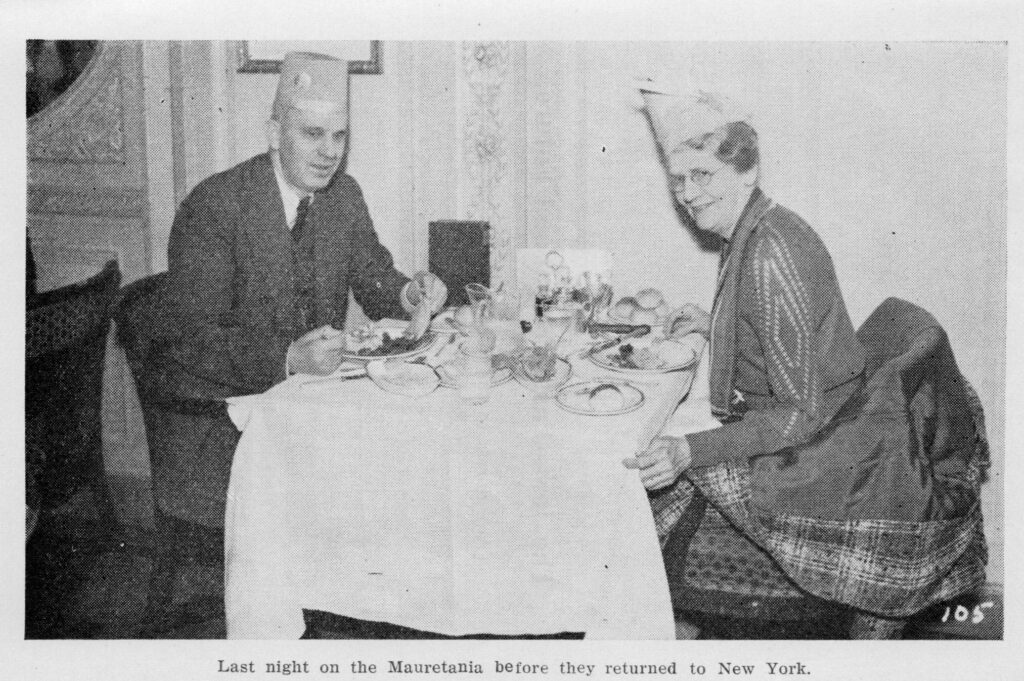
My Fifth Trip to Palestine
Note – This 126-page book was published by Norris in 1948. It details a trip through Europe, Egypt, and the Holy Land. This work stands out for a few significant reasons: first, that it contains so many pictures; second, that is an example of Norris presenting Himself as an expert on world affairs; third, that is presents Norris’s side of his meeting with the pope, which was quite controversial; fourth, that it presents a spirit of adventure of Americans abroad; fifth, that it presents a great appreciation for history; and sixth, that it includes material written by Mrs. Norris. I am somewhat abridging the presentation here by excluding a few elements unrelated to the trip and the text of his speech on “The Jew, Past, Present, and Future“, which I have elsewhere on this site. I have tried to place the images as close to their placement in the book within the flow of the text. – MBG
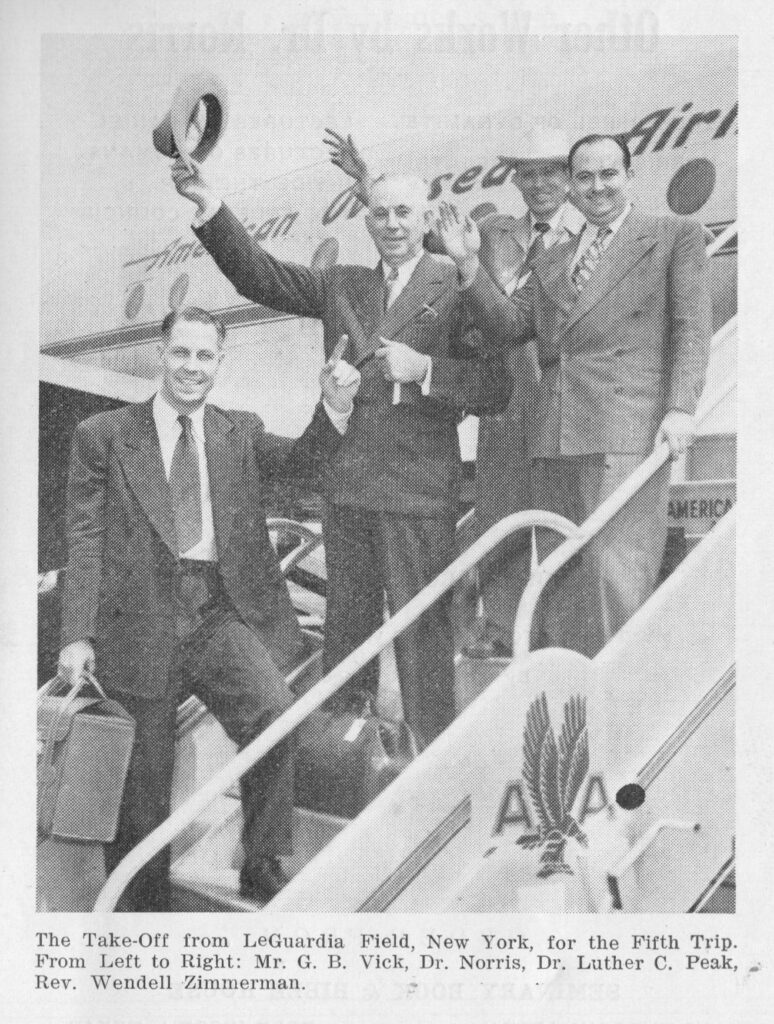
PREFACE
“…of making many books there is no end; and much study is a weariness of the flesh.”
This is not intended to be a book; it is a first-hand view of the land that has affected all civilization, and in turn all civilization has affected it. Indeed, we are now in the fulfillment of Zechariah 12:2.
“Behold, I will make Jerusalem a cup of trembling unto all the people round about, when they shall be in the siege both against Judah and against Jerusalem.”
Prophecy is cumulative, and has more than one fulfillment.
The land that is the home of three great world religions has a heart interest for all humanity – Judaism, Mohammedism and Christianity.
The land that gave us our Bible – every man that wrote the Bible, with one or two possible exceptions, lived in that land.
The land that gave us the patriarchs, prophets, seers and kings of the Old Testament, and the apostles of the New Testament, and above all, that gave us our Lord, – certainly that land has unusual interest.
In its larger area it is bounded by the River Euphrates on the east, the Mediterranean on the west, Mount Hermon on the north, and the River of Egypt on the south.
In its smaller area by Jordan and the Mediterranean, and from Dan to Beersheba – in length about l50 miles and in width about 100 miles.
This little land is the reddest hot subject of all nations of the earth now, and is taking first place in the United Nations discussion.
PRESIDENT TRUMAN REQUESTED INFORMATION ON PALESTINE
Fort Worth, Texas
October 2, 1947.
Hon, Harry S. Truman,
President United States,
Washington, D. C.
Dear Mr. President:
Mr. Matthew J. Connelly wired me from New York October lst and suggested that I write you certain matters of my trip to Palestine.
First, I want to thank you for your very kind personal letter of August 5th which was of invaluable assistance in all my travels.
I have given extensive study to the Jewish Palestinian question. The issue is whether we will take the authority of the Bible of our mothers or the Koran with the
sword and flame.
In that whole controversy the big, issue is who owns the land, who has the title to that land? If that question is settled there is no other question.
The Lord God Almighty in Genesis, the 17th chapter, specifically states that the title to Palestine is given not to Ishmael, the ancester of the Arabs, but to Isaac and his seed for ever.
“And God said, Sarah thy wife shall bear thee a son indeed; and thou shalt call his name Isaac: and I will establish my covenant with him for an everlasting covenant, and with his seed after him” (Gen. 17:19).
The covenant was confirmed to Isaac – Genesis 26:3.
“Sojourn in this land, and I will be with thee, and will bless thee; for unto thee, and unto thy seed, I will give all these countries, and I will perform the oath which I sware unto Abraham thy father.”
This covenant was also confirmed to Jacob Genesis 28:13.
“And, behold, the Lord stood above it, and said, I am the Lord God of Abraham thy father, and the God of Isaac: the land whereon thou liest, to thee will give it,
and to thy seed.”
The covenant was also confirmed to Moses in Deuteronomy 30:3-5:
“That then the Lord thy God will turn thy captivity, and have compassion upon thee, and will return and gather thee from all the nations, whither the Lord thy God hath scattered thee.
“If any of thine be driven out unto the outmost parts of heaven, from thence will the Lord thy God, gather thee, and from thence will he fetch thee:
“And the Lord thy God will bring thee into the land which thy fathers possessed, and thou shalt possess it; and he will do thee good, and multiply thee above thy fathers.”
David specifically states the title to that land is to the Jews and the descendants of Jacob; Psalm 109:9-12:
“Which covenant he made with Abraham, and his oath unto Isaac;
“And confirmed the same unto Jacob for a law, and to Israel for an everlasting covenant:
“Saying, unto thee will I give the land of Canaan, the lot of your inheritance:
“When they were but a few men in number; yea, very few, and strangers in it.”
Thirteen hundred years ago the Arabs were usurpers, Mahomet with fire and sword, and they are robbers of property that belongs to the Jews.
A second and very important authority in addition to Scriptural authority. Great Britain was given mandate over Palestine for the purpose of Jewish immigration into that land and for making it a national home.
This mandate was confirmed by the United States Government and by the 57 Nations of the League of Nations.
The tragedy and the cause of all the present trouble is that Neville Chamberlain, Prime Minister, put on a two-fold appeasement in 1939:
First, with Hitler, and that brought on World War II.
Second, with the Arabs, who were the allies of Hitler. Chamberlain violated the international law giving that land as a national home for Jews in 1939, and said only 70,000 Jews would be permitted to go for the next five years, and after that none except by the consent of the Arabs. But the mandate made no such restrictions.
Therefore, the present Jewish immigration into Palestine is not “illegal”; it’s legal.
Based on the mandate given to Great Britain over Palestine, and confirmed by the United States Government and confirmed by the League of Nations, the Jews invested six hundred and fifty million dollars in Palestine, built cities, public works, and the curse of God Almighty is on every hand that violates this most solemn agreement – the mandate three times over confirmed.
Now, Mr. President, it certainly is a matter that should cause us to stop and think that the Arab leaders from the Grand Mufti on down were allies of Hitler, and it ill becomes them to come now into court with their hands dripping with the blood of the Jews – six million: of them murdered by Hitler.
I interviewed many Arab leaders, and without question I found that the whole crowd are for Stalin, just like they formerly were for Hitler.
While this country was fighting Hitler, thirty thousand young Jews from Palestine volunteered and went to the battle front and not a single Arab regiment.
If the Arabs and Jews in Palestine were left alone they would get along and settle all their troubles.
Russia is doing everything at her command to foment the trouble.
The time has come, and long past, when the United States should keep its promise and take a firm stand for law and order in that land that has given the world its Bible and Saviour.
Yours very sincerely,
J. FRANK NORRIS.
JFN:r
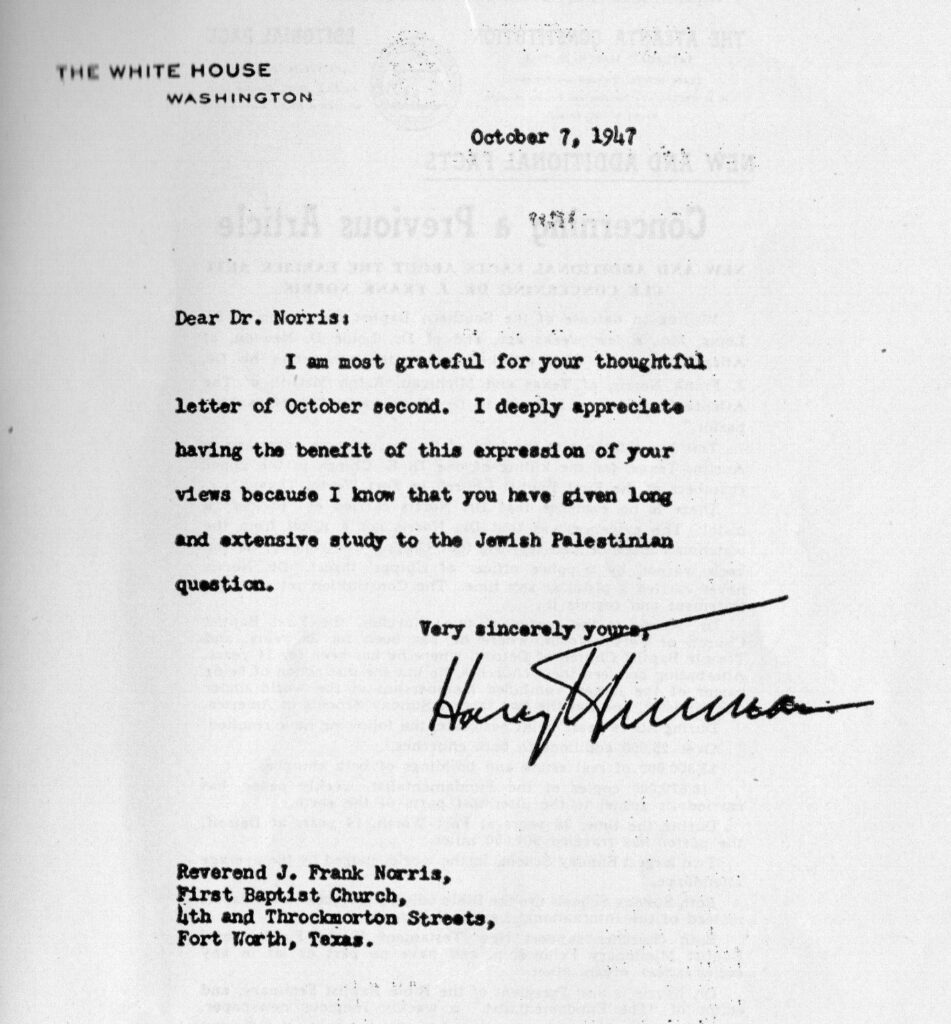
Part I.
The Fifth Trip
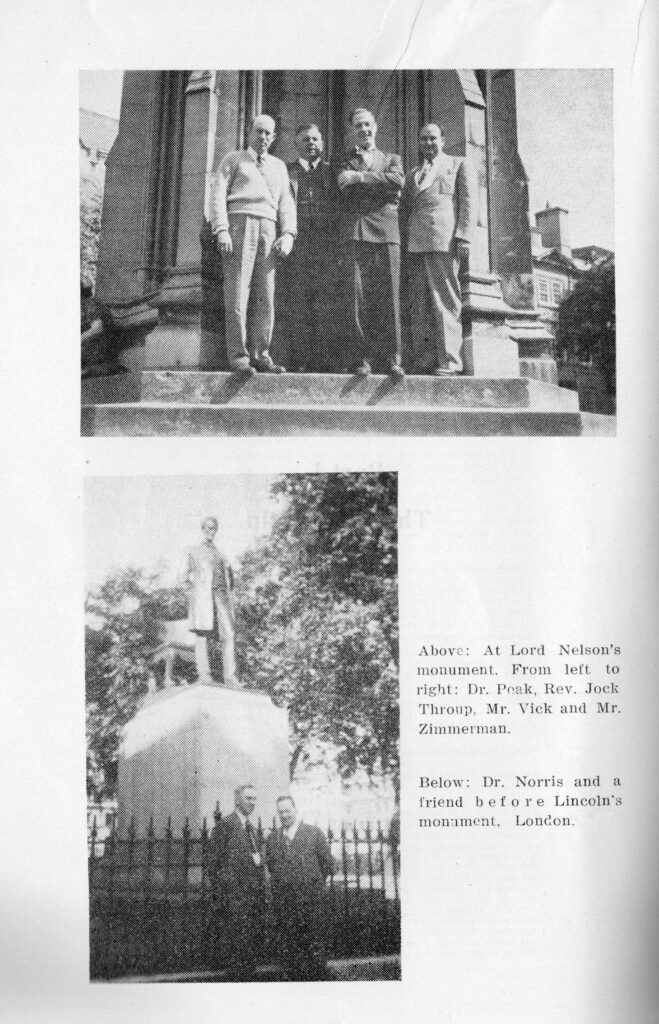
Chapter I.
ITINERARY
Beauchamp Vick and I left Detroit Sunday night after midnight, and in two hours we were at the Biltmore Hotel in New York.
It had been a hard and glorious day at Temple Church and we were both hungry and went out and got some flap jacks and scrambled eggs.
Next day Luther Peak and Wendell Zimmerman joined us. It was their first time in New York.
Through the kindness of my friend, Mr. Tommy Ross, General Attorney of the Chrysler Corporation, we had a fine Chrysler and chauffeur to drive us all over New York.
Then Tuesday afternoon we took the huge “Constellation’ plane” fifty passenger capacity, bound for London.
We had trouble with the rudder or some part of the rear mechanism and made a forced landing at Stephenville, Newfoundland, instead of going on to Gander where we were scheduled to land.
We spent the night at Stephenville, and as soon as we got into our room, all four of us praised God for His special deliverance – “Who redeemeth our life from destruction.” We had many such happy spiritual experiences on our 24,000 mile journey.
Because of the plane accident we had a forced landing at Stephenville, Newfoundland, instead of going to Gander, our scheduled place.
The next day we left on another plane – the first one was sent back·to New York and they sent one to take the place of the crippled plane. And in eight hours and a half we landed at Shannon, Ireland, “Where the River Shannon Flows.”
I have thought several times what would have happened to us if the rudder or tail of that plane had fallen out while we were in mid-air over the Atlantic. I would not be dictating these notes now.
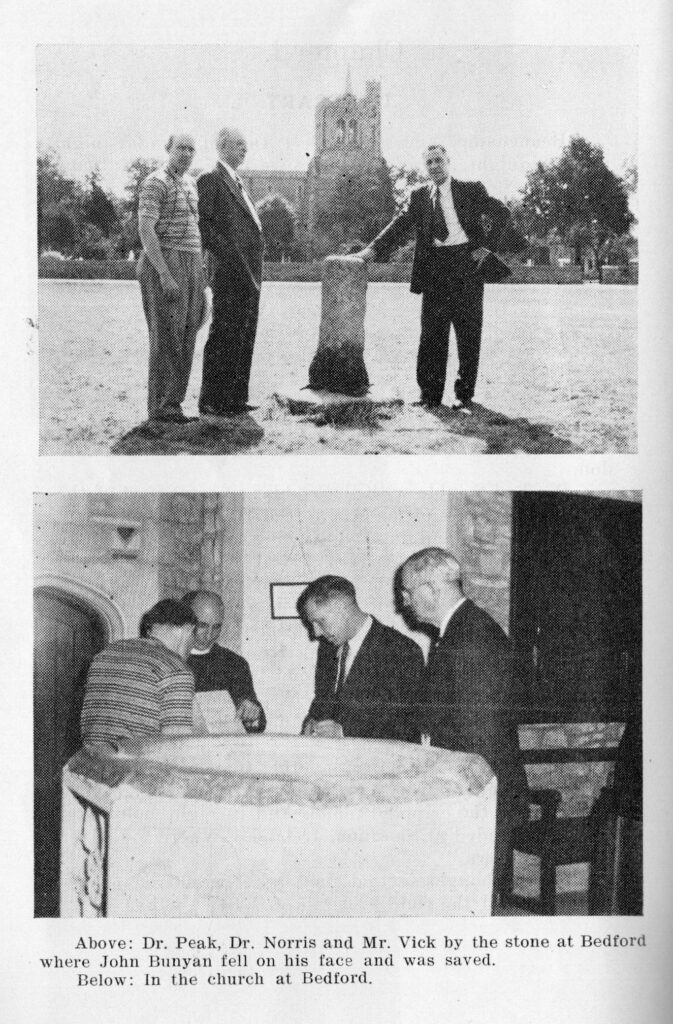
“Father Norris”
A very amusing thing happened at Shannon. The news reporters and photographers were there to interview me – and they interviewed and photographed from the time we left New York until I returned. And not one single time did I ask for it. I did not have a publicity director.
The young man with his camera was at the airport at the foot of the steps of the airplane. And as they came down he kept asking for “Father Norris,” He was a Roman Catholic, and he never thought of anybody being a “Reverend” unless he had his collar in reverse gear. It was with no small difficulty that the other three convineed him that I was “Father Norris.” I have been called many things – good, bad, wise and unwise, but it is the first time I was ever called a Roman Catholic Priest – and this was before I had my private audience with the Pope.
London
Our next stop was at the London airport, and though we were twelve hours late there were four men and two cars from the Ford Motor Company to meet us.
Through the kindness of my friend, Sir Stanford Cooper, we had the accommodation of a Lincoln car throughout the entire trip from London across Europe, to Palestine, and back to Paris, and to Cherbourg where we got on the Mauretania to New York.
This kindness by the Ford Motor Company was invaluable because gasoline costs from fifty cents to a dollar a gallon, and we had a chauffeur and guide, and that
was most invaluable.
We spent a few days in London, and it being the first time for the other three, I took great pleasure in showing them the historic places in the world’s greatest city.
For example, climbing up to the top of the St. Paul Cathedral, three hundred and fifty feet high. Though I had climbed up twice before, yet I enjoyed the exercise – that is of the other three – in making the steep, winding climb.
Mr. C. W. Bowers, Transportation Manager of the Ford Motor Company, made reservation and had us driven to the Savoy Hotel. IIe is one of the finest gentlemen I ever met. He was exceedingly kind to Mrs. Norris and me on other trips. We had one of the finest guides by the name of Mr. Percy Cook, a very fine Christian gentleman.
We drove from London through England, stopping at many historic places. We spent the most of Sunday at Bedford where John Bunyan spent twelve years in Bedford Jail and gave the world “Pilgrim’s Progress,” There is a rock post that marks the place where John Bunyan was converted in a field near the church. The other members of the party knelt on this spot and prayed while I took the pictures.
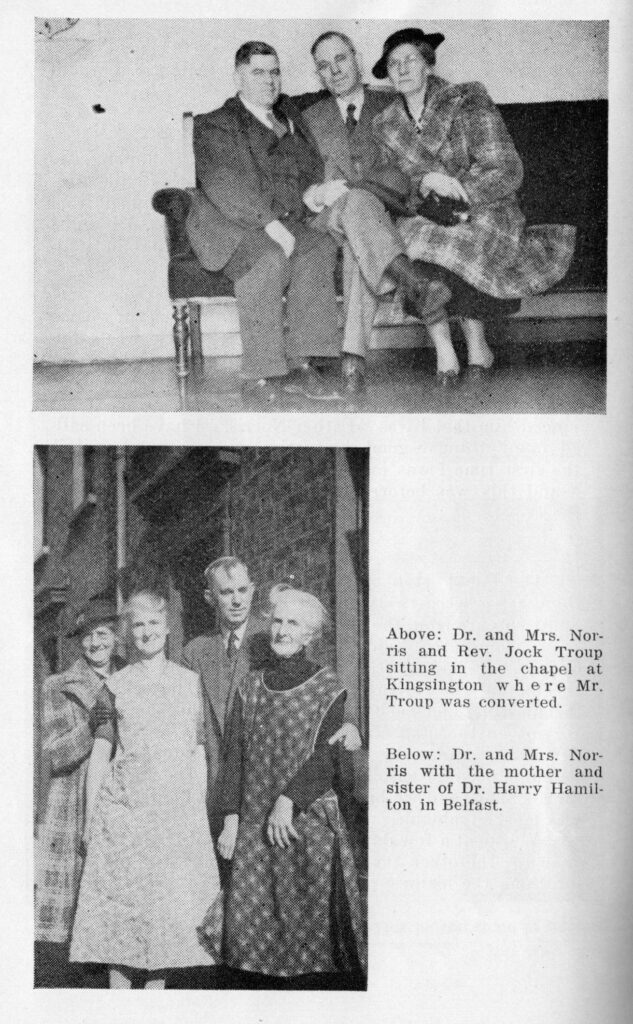
Edinburgh and Glasgow
We stopped at other places throughout historic and beautiful England and Scotland and came to Edinburgh the next day. This is the most beautiful city in the world. We took time to go through St. Giles Church where the revolution against the Catholic oppressors took place and Jennie Geddes threw the stool at the priest.
We spent some time, at the home of John Knox and sat in the chair he occupied, and went through the room where he fell on his face and his family found him the next morning crying his soul out, “Oh, God give me Scotland or I die.”
We went through the Palace of Holyrood where James VI was born and became James I of England and gave us the King James version in 1611.
We saw the room of Mary Queen of Scots and where her ill-fated husband, Lord Darlan, was killed.
We drove to Glasgow and that night we saw the finest play or reproduction of John Knox and the principal actors of his day in the great Reformation.
Jock Troup was not at home. We had had a visit with him at London, but I had his oldest daughter, Ronna, for dinner: What a lovely family Jock has! The other two “bairns” are Betty, 16; and Tan, 14.
Jock had arranged for some special meetings in Belfast and other places for me on my return, but because of a severe bronchial attack I was afraid to risk it and had to cancel these important engagements.
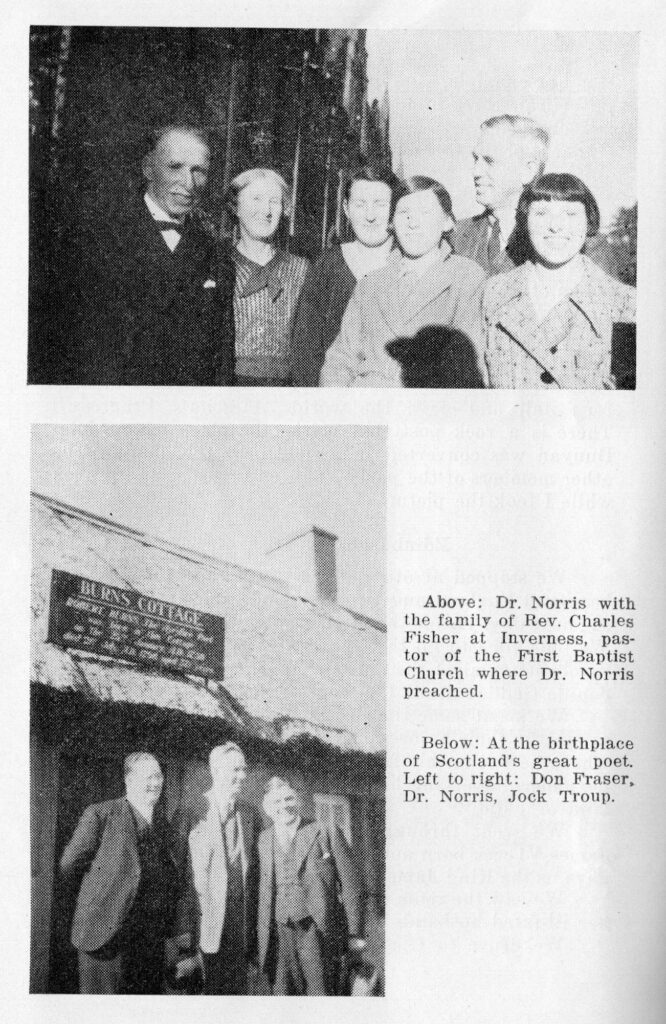
Holland
We took a plane at Glasgow and flew to Amsterdam, Holland, and we were met at the airport by my friends of other trips, Mr. B. C. Huntelaar and Mr, E. P. Bedford. We drove over Holland and it is amazing how Holland has so quickly recovered from the German invasion.
Mr. Bedford drove us to Rotterdam, which was so nearly wiped out by Hitler’s bombs. We had the finest meal there. The other three say the platter or dish was three and a half feet long with a full grown Sole fish on it that covered the entire platter – this is some fish story, but Beauchamp, Luther and Wendell will confirm it – and we licked the platter clean.
Antwerp
Mr. Bedford drove us to Antwerp, Belgium, and there we were met by my friend, Mr. C. Thacker, the General Manager of Ford Motor Company for Belgium, and he had four rooms engaged for all four of us. There was not only a bed room, but a sitting room and a bath room big enough for ordinary people.
And Mr. Thacker paid the entire bill!
The next day we went to the battlefield of Waterloo. We had two cars – Lincoln and Mercury, and four men accompanied us.
Paris
We had another wonderful meal in Brussels, Mr. Thacker put us in a luxury compartment on a through train to Paris, and in four hours we had landed in Paris, And he paid for the tickets!
Again the Ford Motor Company, through the General Transportation Manager, Mr. Felix Gal-Ladeveze, show. ed us every courtesy. I have never met a finer host. His father was a Protestant minister. He is one of the most highly educated and cultured gentlemen that I have ever met. He was our host and guide for several days. Though I had been in Paris several times before, I received more information from “Gal” than from all other guides before.
We met Mr. G. Delamare, Assistant Manager of Ford Motor Company. This is a great factory of some ten thousand employees. I met the General Manager, Mr. M. Dolfuss, on another trip, but he was absent this time.
Switzerland
Mr. Delamare and “Gal” insisted that they drive us to Basle, Switzerland; and we made the trip, a distance of nearly 400 miles, and they phoned ahead and had reservations made at the finest hotel on the banks of the Rhine River.
The next day we struck out “Driving through Switzerland” for several hours, paralleling the beautiful Rhine River. And what a scene of beauty! The most wonderful scenery in the world. We drove across Switzerland, through and over the highest mountains. We spent the night at Lucerne on beautiful Lake Lucerne. The next day we drove to Locarno. We were accompanied by Mr. Weltjens of the Ford Motor Company who rendered every possible kindness.
Rome
Leaving Locarno, we “came to Rome.”
We were very much impressed with how the people of Italy through the Po Valley, the farmers, were all at work. We spent several days at Rome seeing the historical ancient land marks – the Coliseum, Palatine Hill the ruins of Caesar Augustus’ palace, the Forum of Julius Caesar and the Arch of Titus, commemorating the destruction of Jerusalem by Titus, which is perfectly intact to this day. It has on it the inscription in Latin placed there in bronze 1800 years ago, declaring that this arch was built by the Roman Senate commemorating Titus’ victory over Jerusalem. There is on one side a carving of Titus in his royal chariot, crowned with garlands of victory while the vestal virgins scattered flowers before him as he drove through the streets of Rome with his captives chained to his chariot wheels.
On the other side are the two tables of the law, the seven golden candlesticks, and the other sacred vessels from the Temple of Jerusalem.
These same sacred vessels were carried to Babylon, but they were preserved for seventy years, and then they were given back to Ezra and he restored them to the Temple.
But when Titus destroyed Jerusalem that was the last of the sacred relies, for Christ came. He was the fulfillment of the seven golden candle sticks, the mercy seat, cherubims and all things pertaining to the temple worship.
Perhaps, the most interesting thing in Rome to us was the Mamertine Prison where Paul spent his last imprisonment before he went to the block.
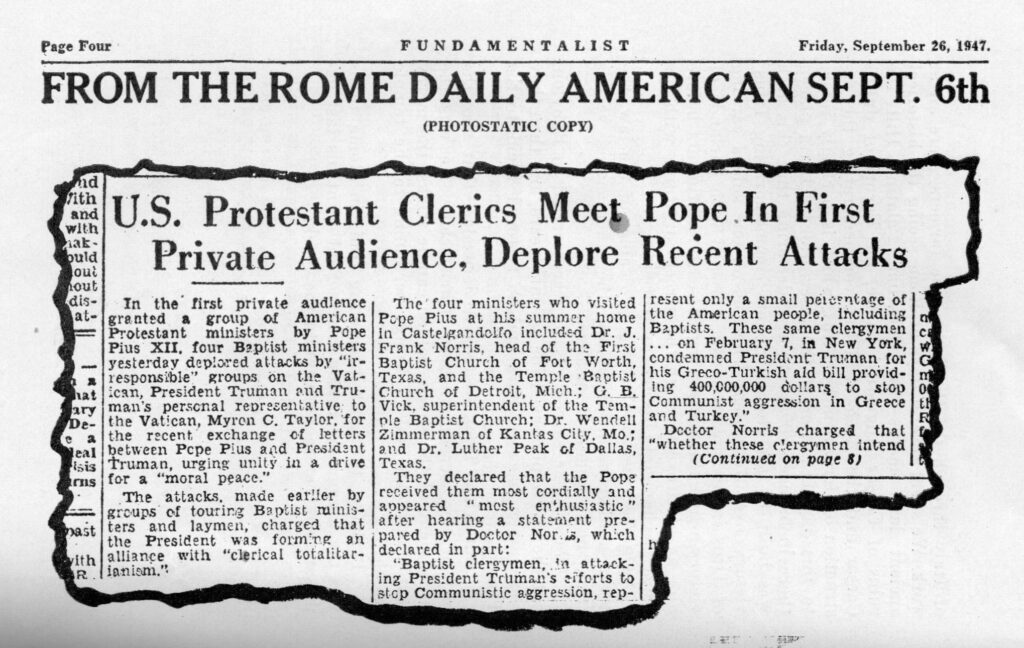
Chapter II.
PRIVATE AUDIENCE WITH THE POPE
The Pope was on his summer vacation and no audiences are held during his summer vacation. But the exception was made and it was arranged for me to see him at nine o’clock one morning. Beauchamp, Wendell and Luther had made the trip the day before from Naples and returned about 2 o’clock in the morning. I did not know whether they would be permitted to go in, but we drove out Castlegandolfo on Lake Alban. I told the Pope’s chamberlain that these three young men with me were my associates, and they went in with me.
The Pope was seated in his room by himself at a small table. There was no throne or paraphernalia about it. There were four chairs arranged in a semi-circle in front of him. He asked us to be seated, which we did, and then we engaged in very free conversation. I made very clear to him my position, which he was gracious enough to recognize, and he knew what we believe as well as we knew what he believed.
There was one point of common interest, and he stated it when he said:
“The time has come for all free peoples of the earth who believe in God to unite against the atheistic, materialistic, communistic conspiracy that is out to destroy this civilization.”
I will join hands with any man on that platform.
Some few narrow minded people, maybe some others who can look through a key hole with both eyes at once, have criticized me for having this private audience, and they couldn’t get on the back door step of the Vatican.
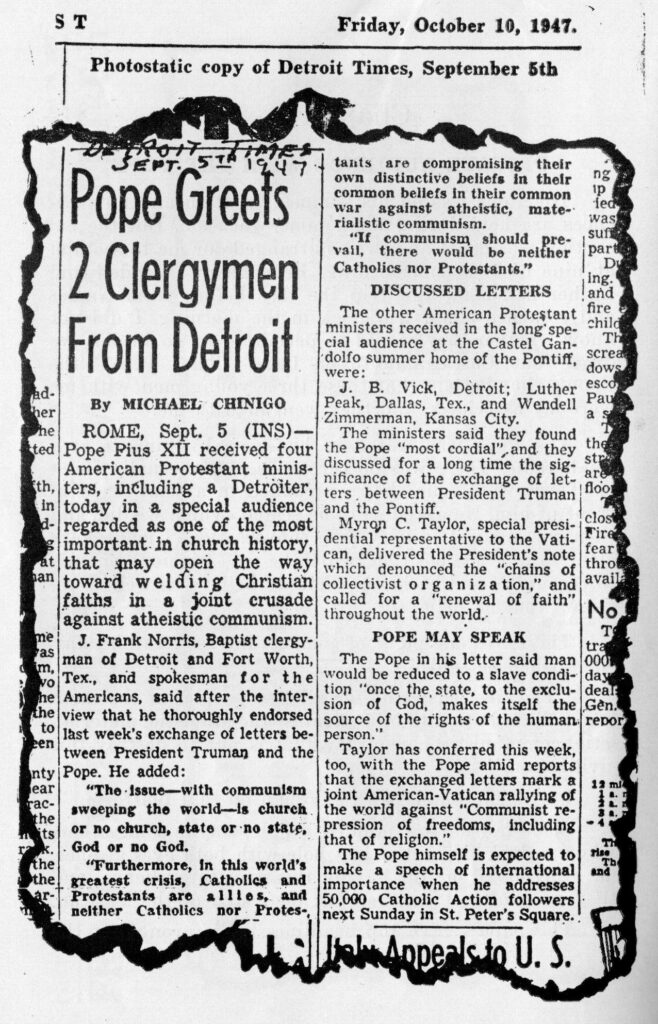
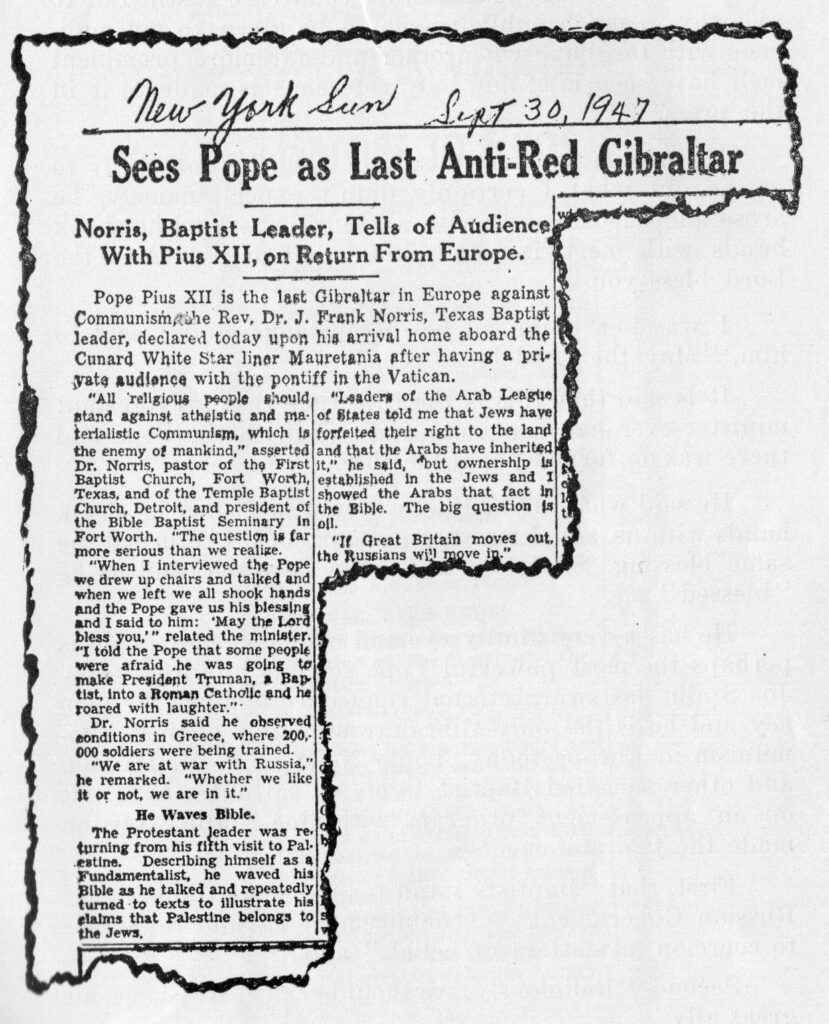
The papers gave top headlines to it throughout the world, not only in America, but in Paris, Switzerland, South America, Egypt and other countries. I still fail to see why so much publicity should be given to my audience with the Pope when other and far more prominent men have seen him, and only reference is made to it in the press.
He was most courteous, and when he got ready to go he did what I certainly didn’t expect, namely, he arose and shook hands with all four of us, and he shook hands with me twice, and said to all of us, “May the Lord bless you.
I was not going to be discourteous, and I said to him, “May the Lord bless you.”
It is said that this is the first time that a Protestant minister ever had a private audience with the Pope and there was no formal papal blessing.
He said what anybody else would say when he shook hands with us, and I was not discourteous. I returned the same blessing. So I “blessed” the Pope as well as he
“blessed” me.
He has a very kindly eye and a very keen eye. He is perhaps the most powerful Pope for one hundred years. Joe Stalin has sworn eternal vengeance against the papacy and he is the only Gibraltar standing against communism in Europe today. Louie Newton, J. M. Dawson and other so-called Baptist lights or satellites have put on an appeasement program with Joe Stalin. Newton made the two statements:
First, that “Baptists stand for the same thing as the Russian Government – renouncement of, and resistance to coercion in matters of belief,” and
Second, “Religiously, we should regard Russia as our great ally.”
Yet there is not a Catholic priest in the world that is a communist.
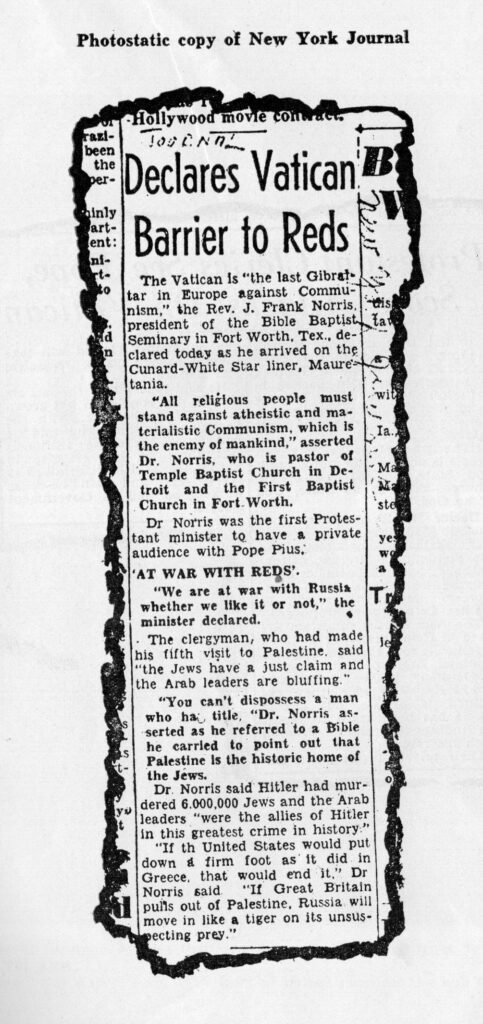
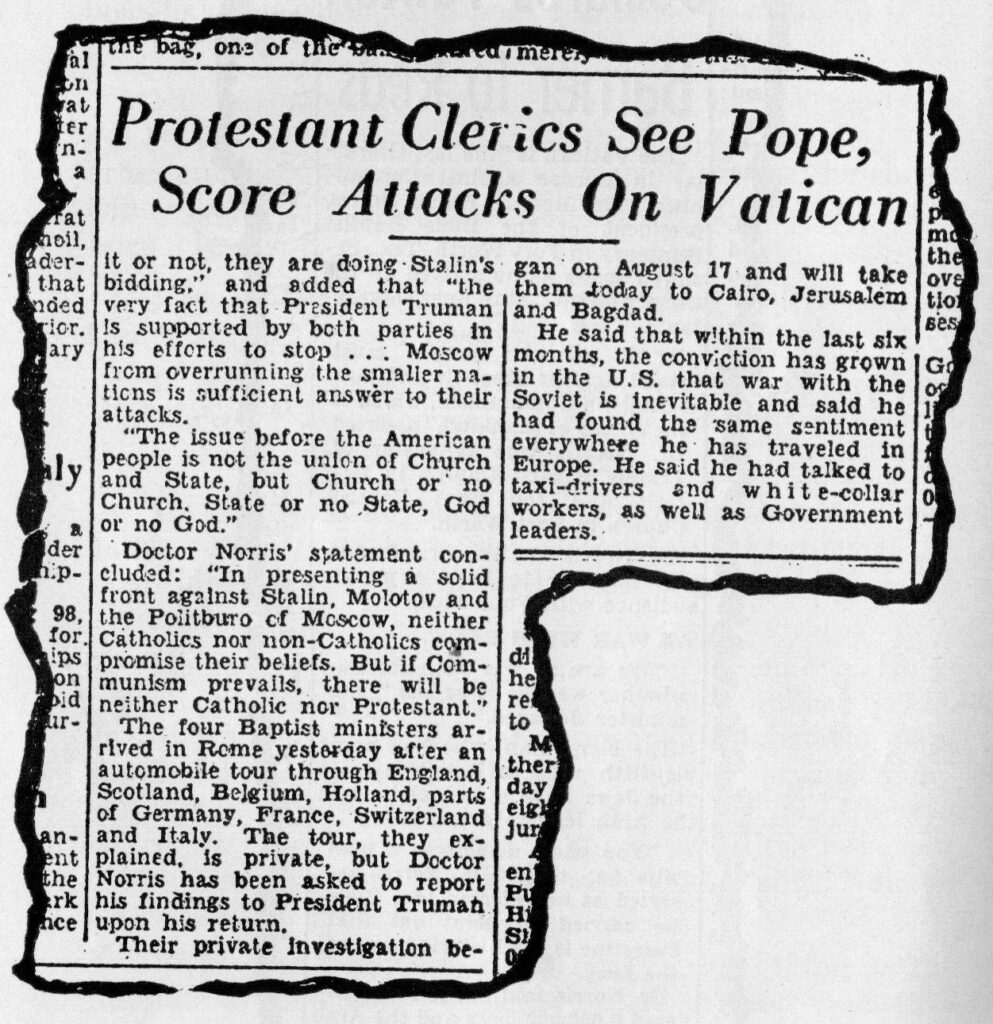
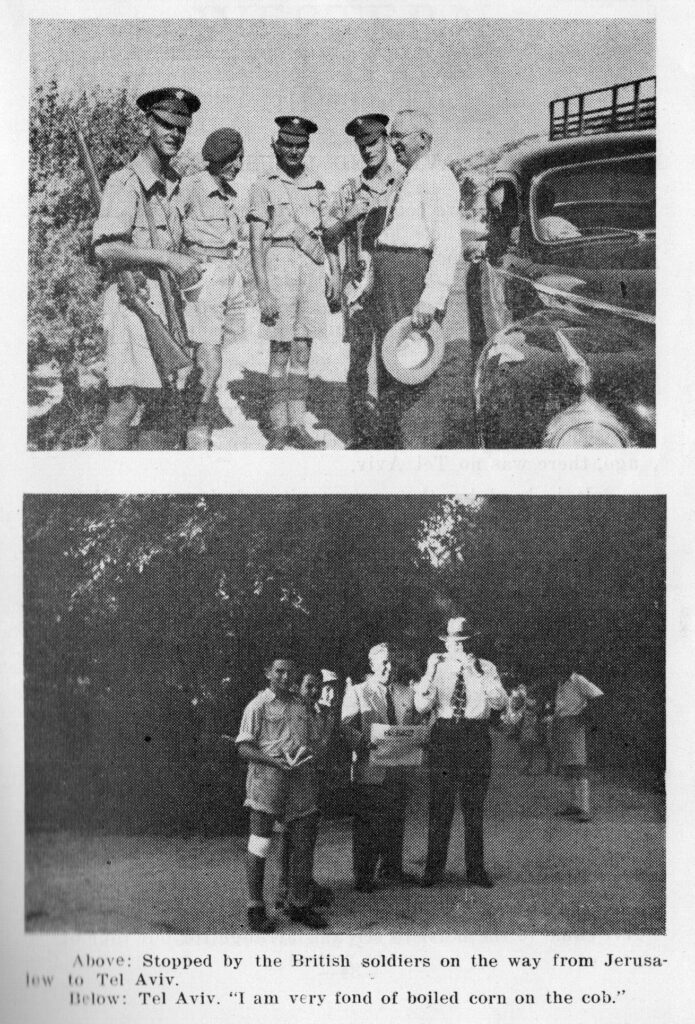
Chapter III.
TEL AVIV AND JERUSALEM
From Rome we took a plane to Athens, and thence to Egypt, and in one hour and a half from Cairo, we landed at the airport at Lydda, one of the largest airports in the world. It was at this airport that our bombers landed before they dealt the crushing defeat to Rommel’s fores just as he was nearing the city of Alexandria.
We drove to Tel Aviv and spent the night and Sunday in a hotel overlooking the Mediterranean.
The first time I was at Tel Aviv, twenty-seven years ago, there was no Tel Aviv.
It is hard by the ancient city of Joppa – a dirty, filthy Arab city.
When I first saw what is now Tel Aviv, it was nothing but thousands of acres of sand dunes. It is now a modern city of beautiful buildings, stores and every modern convenience. It is a city of more than 200,000. It has the finest beach in the world. Beauchamp and I took a plunge and it looked as if the whole city would come out at night and take its plunge in the salt waves.
Right down through the center is Rothschild Boulevard. It has four wide drives with parkways between each drive. The children filled the parkways and streets and everybody was in an hilarious mood.
A young Jew had a container of boiled, fresh Golden Bantam corn, and I am very fond of boiled corn on the cob, and ate it, for I was hungry.
The two top men of the Ford Motor Company of Tel Aviv came to the hotel to see and arrange for our tour of Palestine – Mr. Shaul Lifcheitz and Mr. Eliasiv Kahana, We had a Lincoln car and every courtesy. Mr. M. S. Sanders was our guide. He has a lovely eighteen-year-old daughter. He was born and reared in Jerusalem.
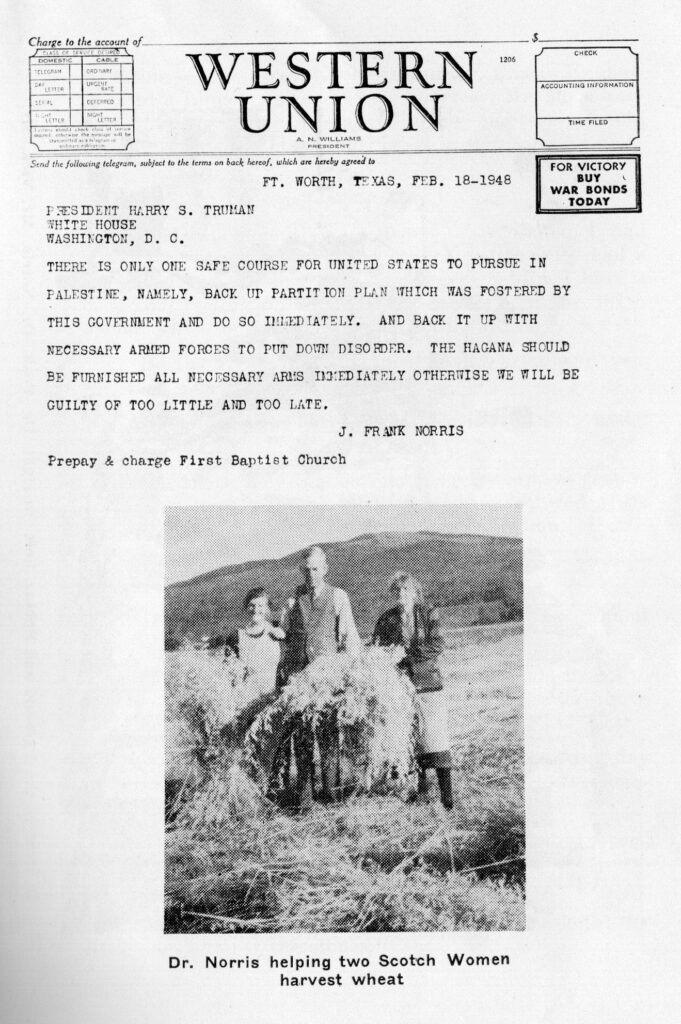
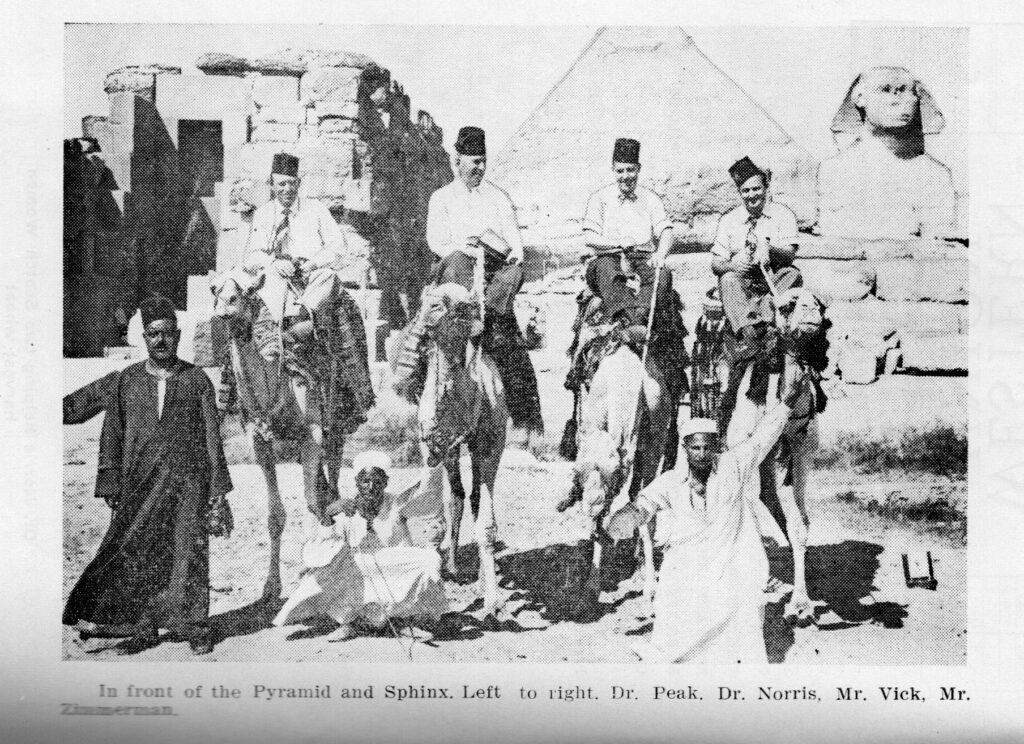
Jerusalem
On Monday morning we drove to Jerusalem. I had been there on four different occasions, yet the city had a deeper, richer meaning to me than ever before. I have a
deep soul feeling for the Jews as expressed in the 137th Psalm, which is the same as the Hatikvah:
“By the rivers of Babylon, there we sat down, yea, we wept, when we remembered Zion.
“We hanged our harps upon the willows in the midst thereof.
“For there they that carried us away captive required of us a song: and they that wasted us, required of us mirth, saying, Sing ts one of the songs of Zion.
“How shall we sing the Lord’s song in a strange land?
“If I forget thee, O Jerusalem, let my right hand forget her cunning.
“If I do not remember thee, let my tongue cleave to the roof of my mouth: ifI prefer not Jerusalem above my chief joy.
“Remember, O Lord, the children of Edom in the day of Jerusalem; who said, Rase it, rase it, even to the foundation thereof.
“O daughter of Babylon, who art to be destroyed; happy shall he be, that rewardeth thee as thou hast served us.
“Happy shall he be, that taketh and dasheth thy little ones against the stones.”
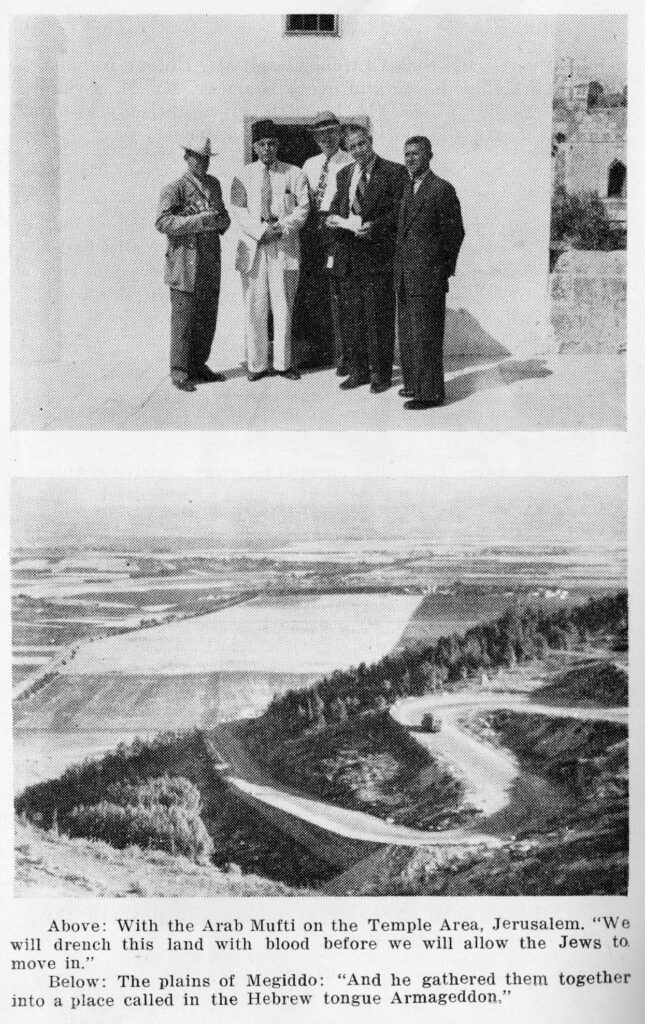
“I Am Coming Here to Die”
I remember well my first trip. As we were going into Jerusalem through the sharp, deep valleys of the Judean mountains, an old white bearded Jew was seated by me, and everybody sang the Hatikvah. Tears coursed down his silver beard. I found that he was from Columbus, Ohio. He was 87 years old.
I said, “What are you coming over here for?”
He said, “I am coming here to die and be buried in the land of my fathers.”
The four of us had reservations at the Y. M. C. A. But that was under military rule, and barbed wire entanglements were around it, and British soldiers at every turn, So we could not stay there. But we had good rooms at the Eden Hotel, the best hotel in the new city. It is modern and it is clean. It is as well furnished as any hotel in America.
I said to the other three, “The first thing we want to do is go to four important places in Palestine – Gethsemane, Calvary, the tomb of Christ, and Mount Olivet.”
We made two other visits to these most important places before we left.
I took them to the old city, going through the Jaffa Gate, and for filth and for all things unsanitary – it can be seen, smelt and felt. As you go down David’s street they have their meat hanging out in front of their stalls. It was warm and I was in my shirt sleeves and rubbed up against a whole half of a goat. I had to change shirts immediately.
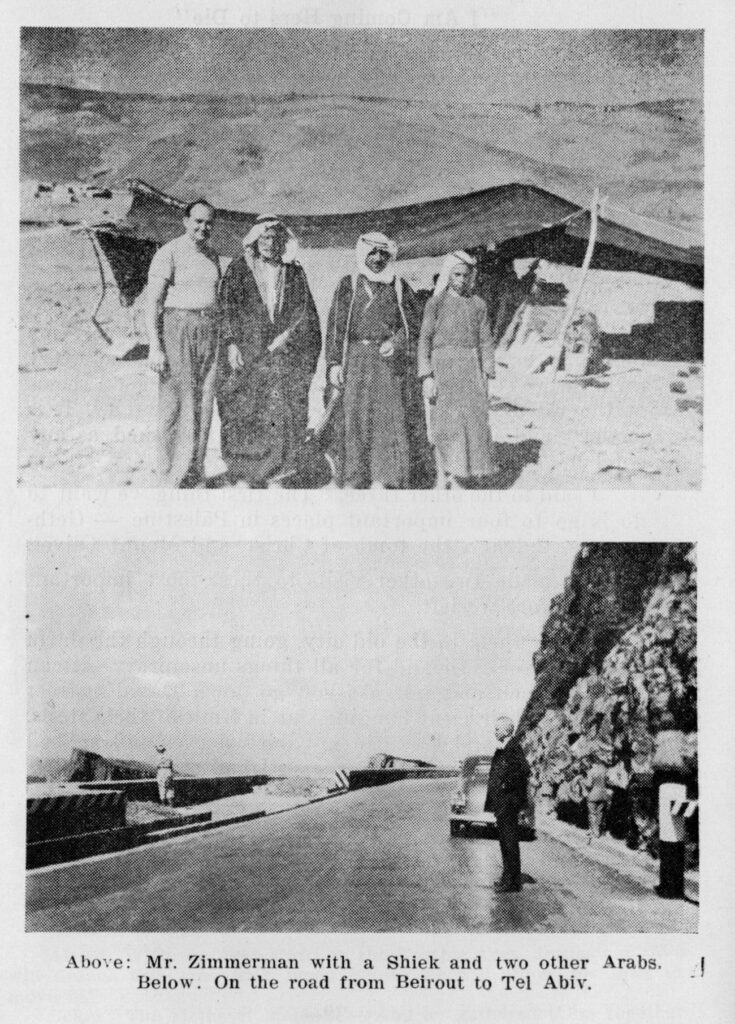
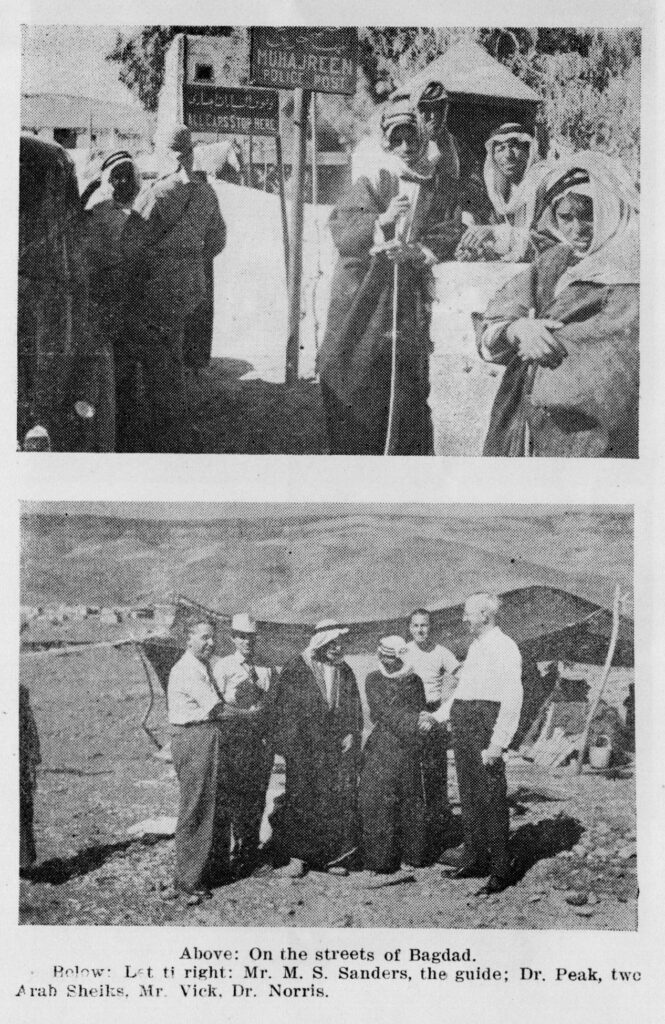
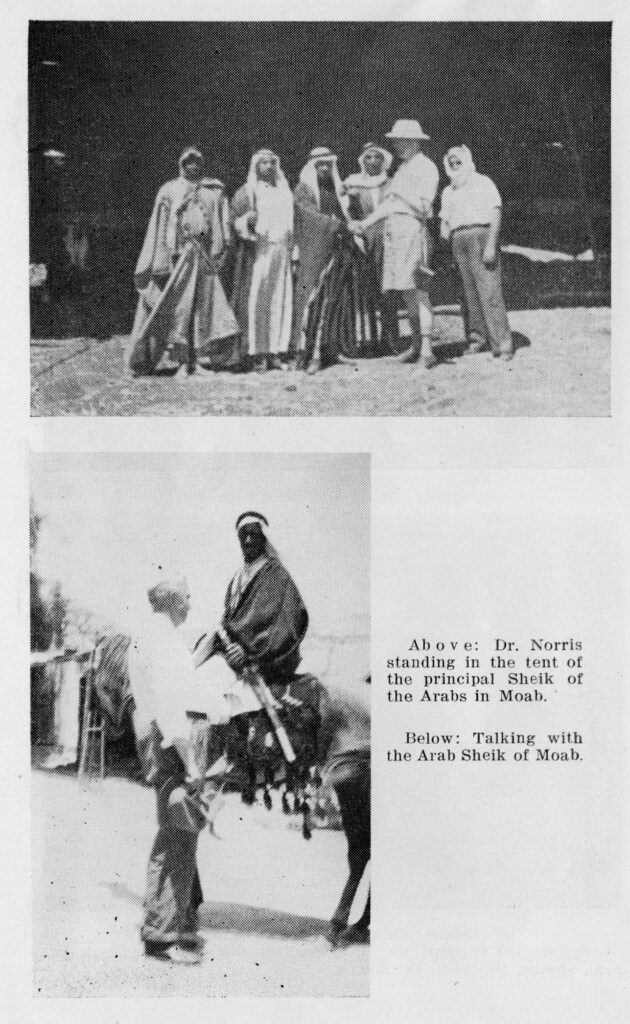
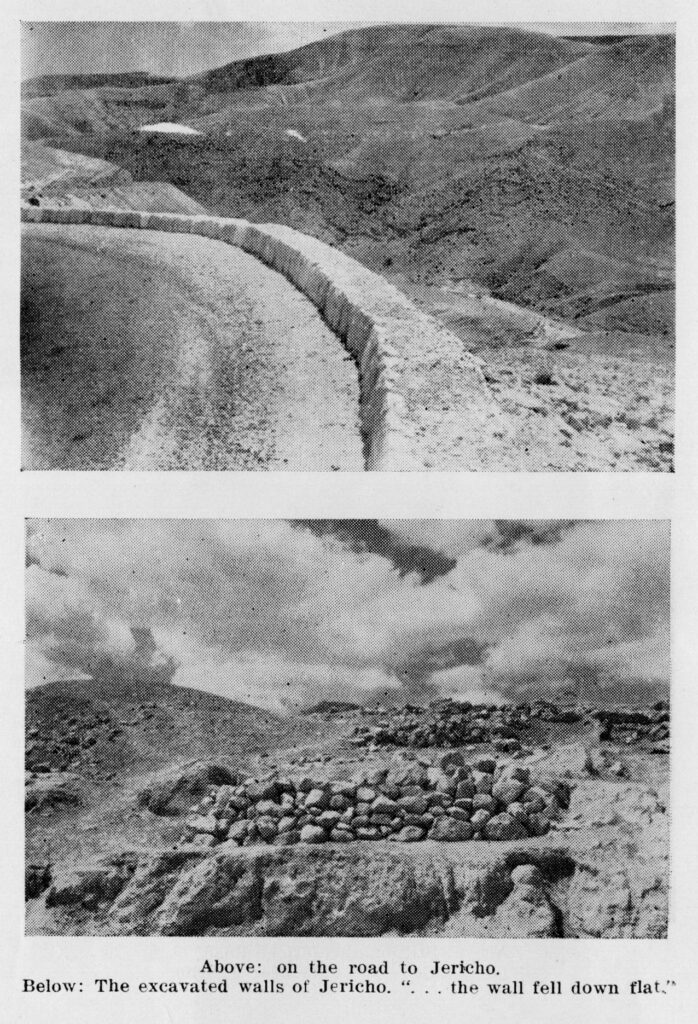
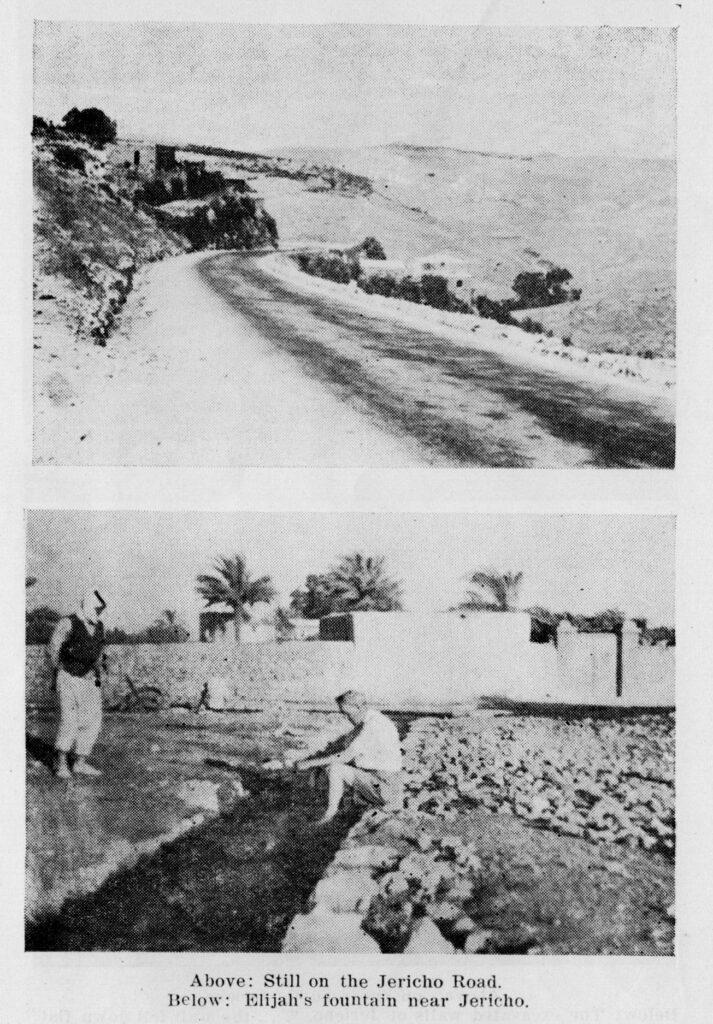
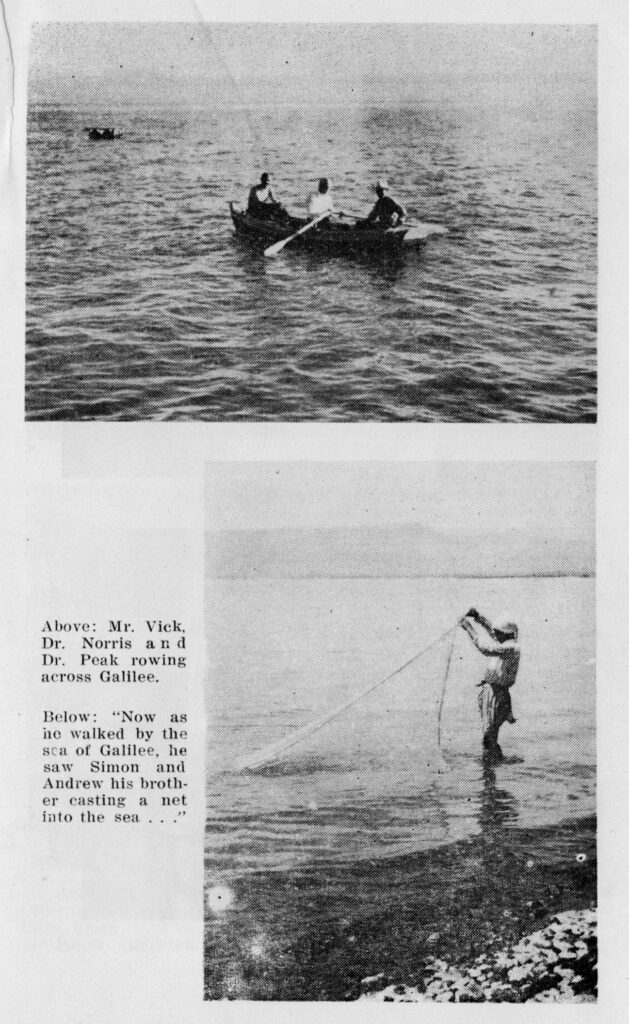
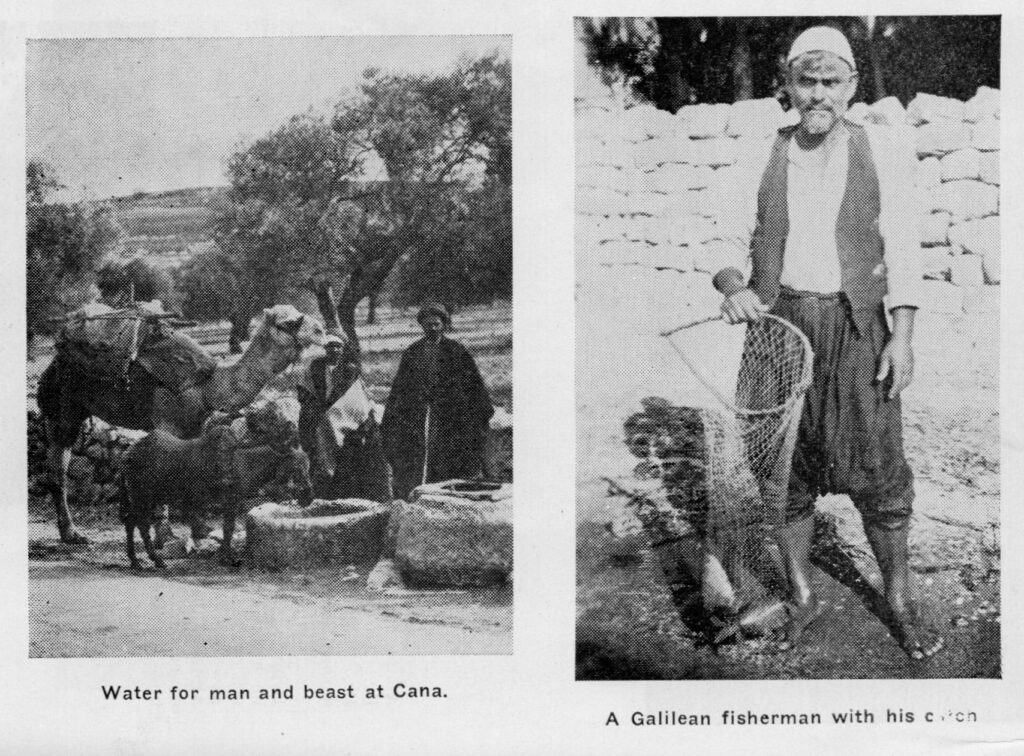
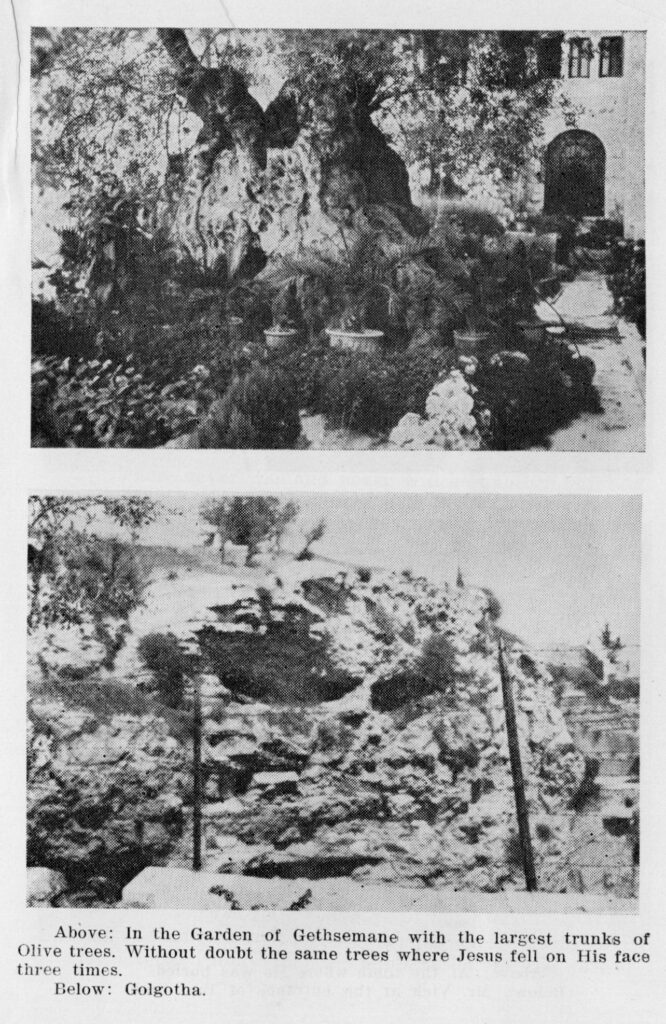
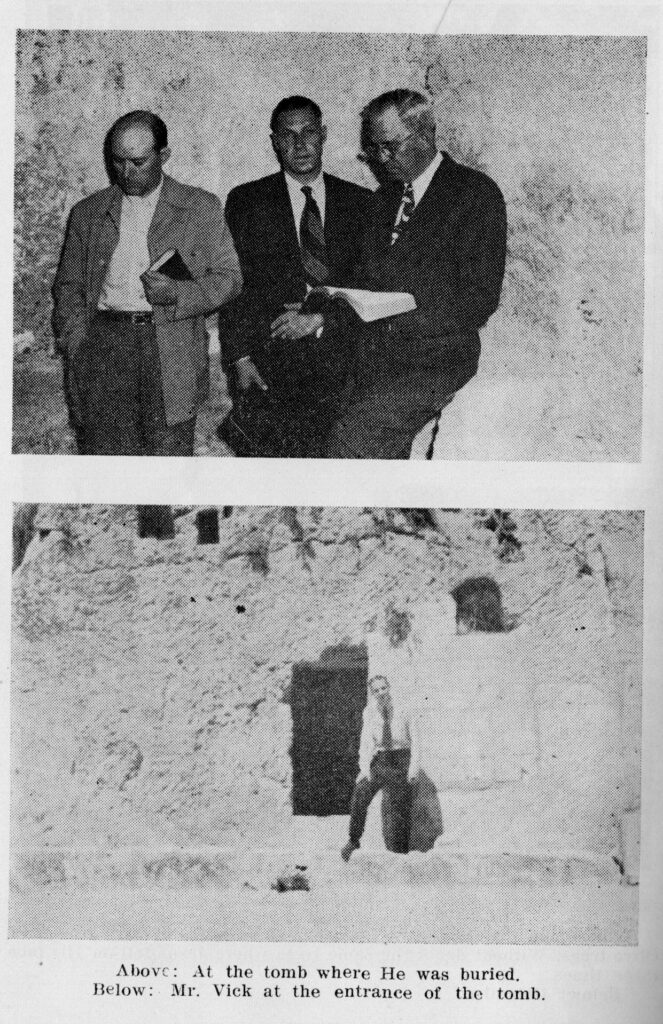
Chapter IV.
JERUSALEM
Jerusalem is the most important city in the world, and in all human history. It has affected every nation on earth and in turn every nation has had something to do with Jerusalem – Egypt, Assyria, Nineveh,Babylon, Edom, Moab, Macedonia, Greece, Rome, and all the empires and nations throughout medieval times, and at present every nation both in and out of the United Nations.
Solomon’s Temple
There never was and never will be another building, or buildings that can compare with Solomon’s Temple. It was David who first proposed to build the Temple, but he was forbidden, and although he collected materials, the execution of the task was left. for his son, Solomon.
According to the best authorities the gold and silver alone accumulated by David for the Temple construction amounted to between two and three billion dollars.
Solomon began to build the Temple the fourth year of his reign, possibly 1012 B.C., and completed it in seven years.
There were 183,000 laborers employed in the construction, 70,000 bearers of burdens, 80,000 hewers of wood and stone, 3600 overseers.
The parts were all prepared at a distance from the building site, and when they. were brought together the whole construction was erected without the sound of a hammer, ax or tool of iron. The entire area enclosed by the outer walls formed a square of about 600 feet. However, the sanctuary itself was comparatively small as it was intended only for the ministration of the priests while the congregation assembled in the courts. There were chambers built around the sanctuary for the abode
of the priests and the attendants.
The ground plan measured approximately 120 feet by 60 feet, and it was 45 feet high.
The Temple consisted of three parts, the porch, the Holy place and the Holy of Holies.
The whole interior was lined with woodwork richly carved and overlaid with pure gold.
In the Holy of Holies was the ark of the covenant. Cherubims of gold overspread the mercy seat.
In the Holy place,besides the altar of incense which was made of cedar overlaid with gold, there were ten golden candlesticks and ten golden tables bearing the shew-bread and innumerable golden vessels for the Temple service.
According to the best information the outer court measured 150 feet north and south by 300 feet east and west.
“His Blood Be Upon Us”
As we sat and watched the Jews at their wailing place I thought their prayer has indeed been answered when they said to Pilate:
“His blood be upon us.”
Invasions
Space would fail to tell of the many invasions – twenty-two invasions and seven times the City has been destroyed!
To call the roll of all the military leaders with the title of “The Great” – practically all had war with and made conquest of Jerusalem, Thotmes, Nebuchadnezzar, Sennacherib, Cambyses, Alexander, Pompey, Caesar, Augustus, Titus Hadrian, Omar, Saladin, Tamberlane, Napoleon – all gone, and their governments and empires are no more.
Think of it! Here is where good king Asa defeated one million Ethiopians.
Revivals
One of the greatest revivals of all times took place here under good king Asa under the very conditions that we now face, and which prevailed nine hundred and fifty
years before Christ.
Here is where Jehoshaphat reigned and made the fatal mistake that some Baptists are now making of entering into evil and entangling alliances with modern Ahab.
Here in this very place was one of the wickedest women of all time who ruled and was slain by the good priest Jehoiada, and the boy king Joash was elevated to the throne.
Here is where good king Hezekiah turned the people back to Jehovah.
It was under and during the reign of Hezekiah that Sennacherib surrounded and besieged Jerusalem and it was the voice of the prophet Isaiah that delivered the city.
And the same Lord of Hosts that slew the Assyrian army one night will slay the Beast and his armies at Jerusalem.
It was here that the great statesman, King Uzziah, reigned for fifty-two years. And the year of his death witnessed the call of the great prophet of all time.
Again we witness under the reign of young King Josiah the same two necessary fundamentals of every revival:
First, a destructive work, and
Second. a constructive work.
What History!
As I stood and looked over the city – what history! Here is where the bloody and cruel Idumean, Herod the Great, ruled for more than a generation.
Here the wise men came from the East.
Indeed the King of kings had come!
Gone is Herod.
Gone is Caesar Augustus who issued the only decree on record that the world should be taxed.
Another Caesar will rule the whole world – during the Great Tribulation. Are we coming to that awful hour? The true believers will not go through the Great Tribulation; but they will go up to the very beginning, the twilight period. Are we approaching that period of dimness: I think so – “But it shall come to pass, that at evening time it shall be light. “
Here within the walls of this dirty old filthy city Jesus performed many miracles.
It was here that Jesus healed the impotent man who was lying by the pool of Bethsaida, and in this city as Jesus was passing along the narrow streets he saw a man who had been blind from birth, and healed him.
And again I recalled the miracles the Master performed on the Sabbath day when He healed the man which had the dropsy.
Somewhere in this city – the exact location doesn’t matter – was the last Jewish Passover of Jesus with the Twelve; then immediately after His own memorial with the Eleven.
Kedron
The Brook Kedron is most surely the same as that night, the same as when David fled across from the wrath of Absalom, All the important places are clearly identified. After all that “tradition,” monks and monasteries have done, yet there remain the “landmarks.”
What feelings as we read and looked down the valley.
Gethsemane
Gethsemane is across the Brook Kedron at the foot of Mount Olivet to the northwest, about one-half or three fourths of a mile from the walls of Jerusalem. There is no doubt about the place. What resolves, what emotions, what surgings, what new courage!
Oh for that “one hour.” If for just “one hour,” what a new life, a new church, a new preacher!
A man would be wood and stone to keep back the tears.
What a tragic picture of this old wicked world today! They gambled away their own salvation, their soul’s destiny forever. Millions are doing that this very hour!
But I indulge the hope that many of these gamblers at the cross, many of that mob were converted, like the Roman Centurion who was in charge of the crucifixion.
I rejoice to think that for sure there were two glorious examples of salvation at the death of Jesus.
As I stood on Golgotha it was not difficult to roll back more than 1900 years and stand in that three awful hours of darkness and hear the seven immortal sayings of
Jesus.
Chapter V.
A SWIM IN THE DEAD SEA
It is the strangest body of water in all the land.
The water is so intensely saline that the shoulders stay out of the water all the time while swimming, and in wading when a man gets out where the water is deep enough to reach the arm pits he is swept off his feet.
The River Jordan flows into the Dead Sea, but it has no outlet. This heavy inflow is carried off by evaporation alone. Six to eight million tons of vapor rise into the hot air every day, and this evaporation produces strange blue-white clouds which float half-formed and ethereal above the waters.
On the eastern side rise the mountains of Moab, and from there can be seen the devastated wilderness of Judea. On the western side is the plateau on which Abraham and Lot stood to behold all the plain. In Genesis 13:10 the land is compared to Eden, it was “even as the garden of the Lord” before the catacliptic destruction of the district with Sodom and Gomorrah, described in the 18th chapter.
The Dead Sea is 47 miles long and at its widest stretch is ten miles across. It is 1300 feet below sea level.
It abounds in salt, which was a royal monopoly in the time of Herod the Great.
There are great cliffs 600 feet high on the southwest which was the source of the salt of which Jesus spoke which they secured to preserve the Galilean fish, and the housewives store of food.
On the eastern shore on a great mass of rock, Herod built his castle Machaerus in which John the Baptist was imprisoned.
Great quantities of bromine and potash are produced. The heavy charged water is pumped from the sea into great evaporating pans where the most valuable minerals are recovered. Since Great Britain obtained the mandate for Palestine the Dead Sea has been largely developed by British interests. Investigation shows the sea to contain riches beyond the dreams of avarice. The potential resources of potash deposits are estimated at two thousand metric tons, while its potential supplies are almost inexhaustible in quantity. America buys large quantities from an European potash trust for her agriculture at a very high price.
The minerals in the Dead Sea are estimated to have a commercial value of twelve hundred billion dollars. Little did the people of Palestine in the time of Christ dream that in this expanse of water lay the potentiality of such immense riches.
“There are large quantities of magnesium, sodium, calcium and potassium, chlorine, bromine, suplhate, carbonate, silica and others.
The chloride of magnesium gives the water its bitter taste, and chloride of calcium gives it a smooth, oily feeling. When the water dries on the hands or clothing it has a disagreeable stickiness.
No animal life can exist in this water. The fish brought down by the Jordan die and are eaten by the sea-birds.
No other sea has had such a variety of names. “Dead Sea” was first introduced by the Greek writers.
To the Hebrews it was the “Salt Sea.”
The Arab writers called it “the sea of Zoar,” the Stinking Sea,” “the Sea of Overwhelming,” and “the Sea of Lot.”
Down under the waters excavators have found the ruins of the wicked cities of the plain.
I believe it all happened just like the Bible records it.
Chapter VI.
“I was behind in my praying but caught up in that storm of the Mediterranean” – Luther C. Peak.
I have been in a few storms while flying – two in particular – in the years gone by. One in 1939 when my wife and I were crossing the Bay of Bengal, and it was a most terrific storm, and that French air liner would buckle like a bird in the high wind.
We battled it all day and late in the afternoon we left the storm behind and I looked on one side and saw a perfect, completed rainbow.
The sun was about an hour high, On the other side was a full orbed moon. How peaceful, and what joy!
I have the same Bible that I marked the last verse of the first chapter of Ezekiel which says:
“As the appearance of the bow that is in the cloud in the day of rain, so was the appearance of the brightness round about. This was the appearance of the likeness of the glory of the Lord. And when I saw it, I fell upon my face, and I heard a voice of one that spake.”
I was in another storm over the Atlantic in 1941, returning from Lisbon in the Atlantic Clipper. And for two hours it looked certain we would feed the fishes. I don’t enjoy these storms, and any man who says he is not afraid of one, he is a post graduate of the Ananias Club.
But the last one was when we were crossing the Mediterranean, going from Rome. Luther and I were sitting together. Wendell and Beauchamp were across the aisle. Suddenly that huge Constellation plane took a vertical drop. How far we dropped I don’t know. And no sooner than it dropped it bounced back and dropped again. And thus we were jumping and dropping five hundred to a thousand feet or more, said our host, at a time
After it was over Luther said, “I was behind with my praying, but I caught up in that storm.”
Every time I get in a storm in a plane, I vow to high heaven I will never get in another one. It is true I have a seat on predestination, but in a storm at sea in an airplane I am sometimes afraid I will slip off my predestinated seat.
However I guess I will take another trip, maybe so.
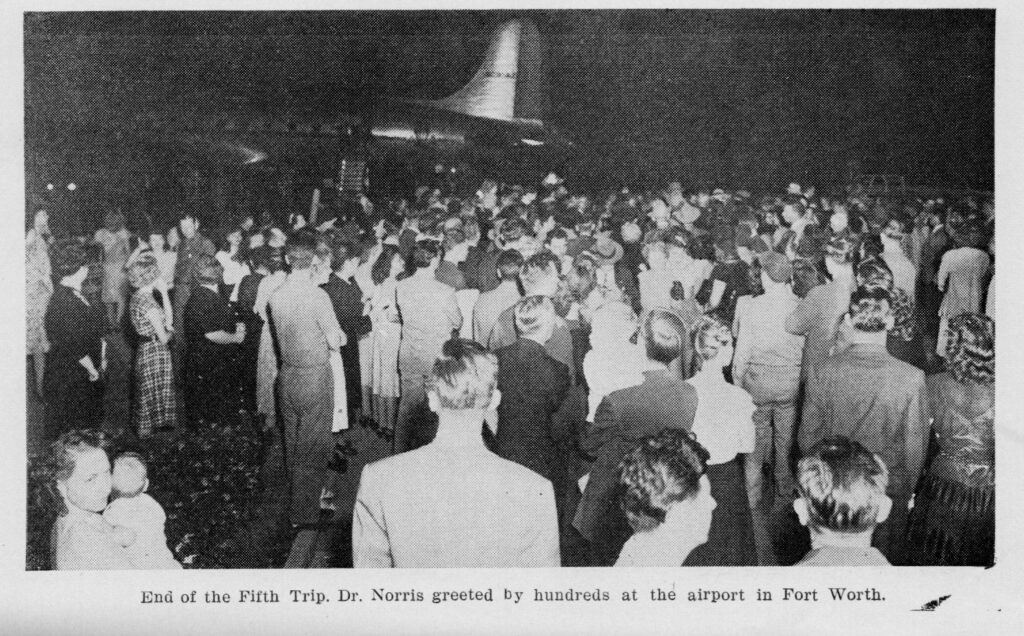
Part II.
Two Letters From Mrs. Norris
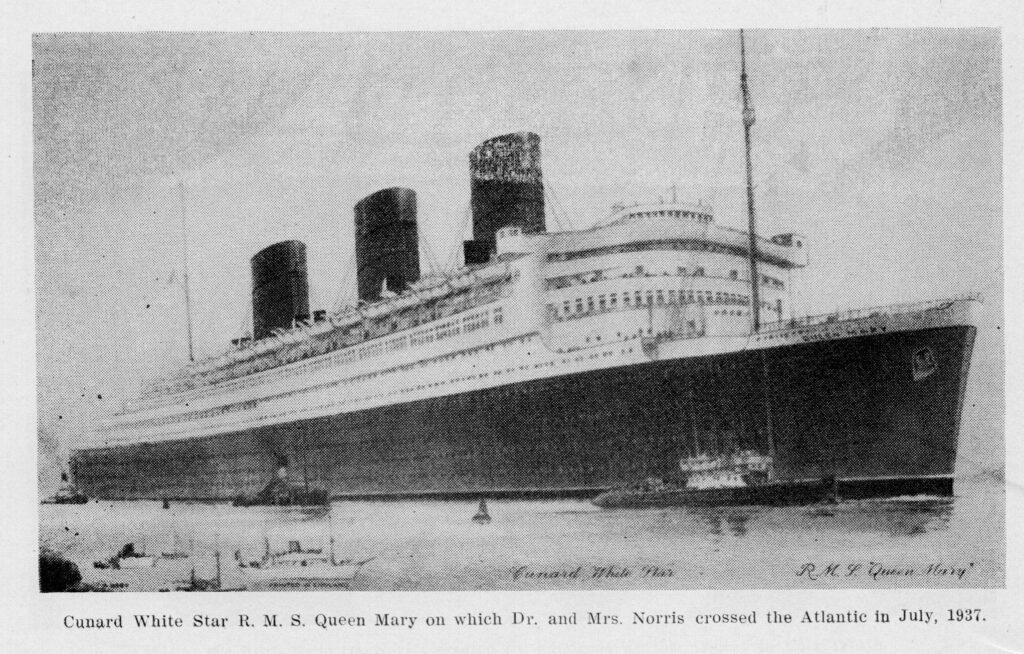
Chapter VII.
EGYPT
Jerusalem.
Dear Folks:
This is to warn you that you are never to go down to Egypt.” First of all, it certainly was “down” in every way to us. We had had such a marvelous stay in Athens – and the trip across the Mediterranean had been most ideal, with perfect weather, perfect sea, perfect ship, perfect sunshine, and perfect moon-shine; but all the while we were going “down” (South) to Egypt.
First of all, let me admit I am prejudiced against Egypt. If I had never read the Bible at all, yet I feel that intuitively I would have had the same feelings, yet perhaps not knowing why.
I think Egypt, both land and people, are like the river Nile. Certainly there is mystery everywhere, and not only has the Sphinx not solved the riddle, but no one has solved the riddle of the Sphinx.
We walked around and looked on and up to and over and beyond the Sphinx, but I didn’t notice its riddle. Our guide told us it was to point the people to the worship of the Sun. It shows the ancients knew how to work. The pyramids give you the same idea. Somebody worked. And they tell us, and we know it from history, it was the poor slaves.
I certainly am not going into any archaeological discussion, but tell you we saw all the ruins and antiquities of Europe and would not have missed it for anything. We saw some of the most wonderful things from the tomb of King Tut. How amazingly rich those kings were, and what mysteries are still hidden down in that pitiful country, only time will show. Their museum is one that I truly found amazing. We had a good and intelligent guide, but he proved at the last that they are all exactly alike – no matter what your agreement with them may be, or how well you may pay them, they are going to ask for, expect, and beg you for something extra, and they usually get it. He got his extra, too.
One of our great delights “down in Egypt” was a trip through the great park there in Cairo, especially the botanical gardens. It was most wonderful for me. It was “down in Egypt, ” that Mr. Norris had the inspiration to buy an umbrella, and it’s the most beautiful umbrella you ever saw. Why on earth I got off without one I have no idea. When I got ready to come on another trip before some dear friends ‘gave me one, but I forgot it this time, but certainly have one now.
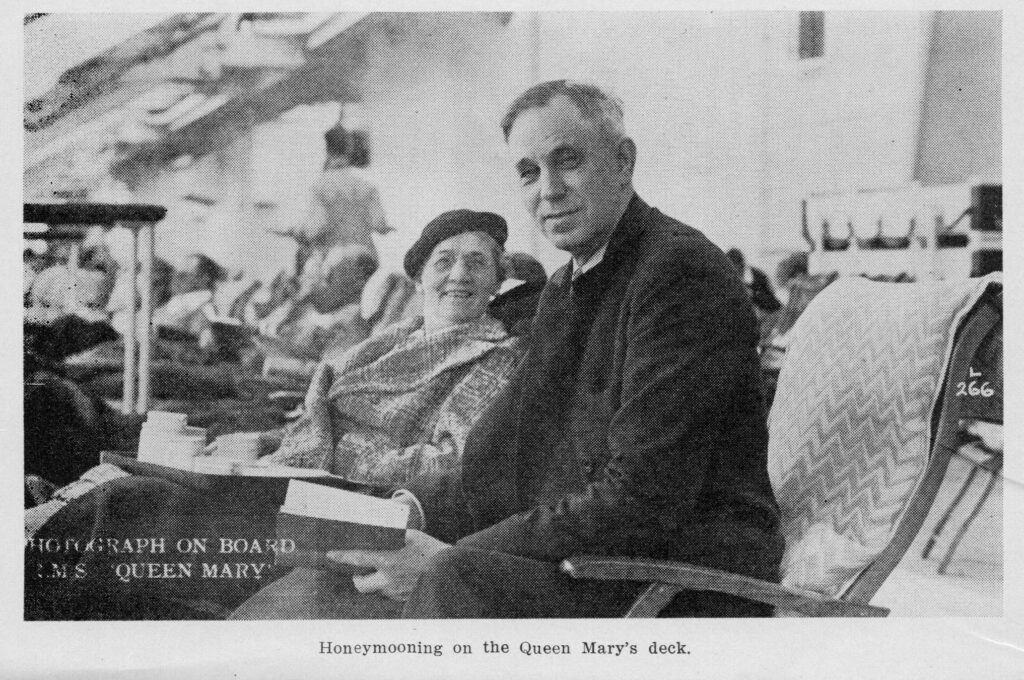
Strong Contrasts
Egypt is a land of strong contrasts. I saw beautiful and magnificent homes and I saw men sleeping in doorways like stray dogs. I saw mansions, modern in every way and I saw men, women, and children sleeping out on the sidewalks. Such fertility of soil, rich luxuriant vegetation I never saw, and yet such pitiful want and need I never saw. Such beauty and such ugliness side by side, I never saw, before.
The hotel where we stayed had the same contrast. It was wonderful and gorgeous and beautiful, yet the workers had a kind of uniform. Some had one kind, some another, of long dress. Some clean, some not so clean.
As usual they thought we were “cracked” because we had no use for the wine list. I’ve decided we should get us one or two polite sins to keep the waiters from thinking we are peculiar-not that we are without sin, but ours do not seem to be the right kind. What would you suggest?
The women in Egypt, I’d say almost one hundred women, mostly in modern dress, but I do not know whether any of them were Egyptians. We saw some very, very fine people and they were exceedingly kind. There was one man who rode in the same section on the train with us. He wore western clothes – a good suit, probably tailor made, and his red fez, which seems to signify nothing more than a popular kind of hat. He was intelligent, well informed, widely read.
Alexandria
We landed at Alexandria and I looked my eyes out. The landing was interesting, and the landings are always interesting to me. Of course the routine is always about the same. The doctors came first, health inspection. Then the police. All of this is important and necessary. That’s why we have Ellis Island, and there are often good and sufficient reasons for people being detained at Ellis Island, too. And a lot of foolish sentiment should be forever banned when it comes to questions of who is to enter our country.
While waiting there we had a splendid view of the city using the field glasses, It looked quite modern and
clean. But on closer observation it did not look so good I wondered if that great library had not been destroyed and the people had read more, perhaps we might have had a different story.
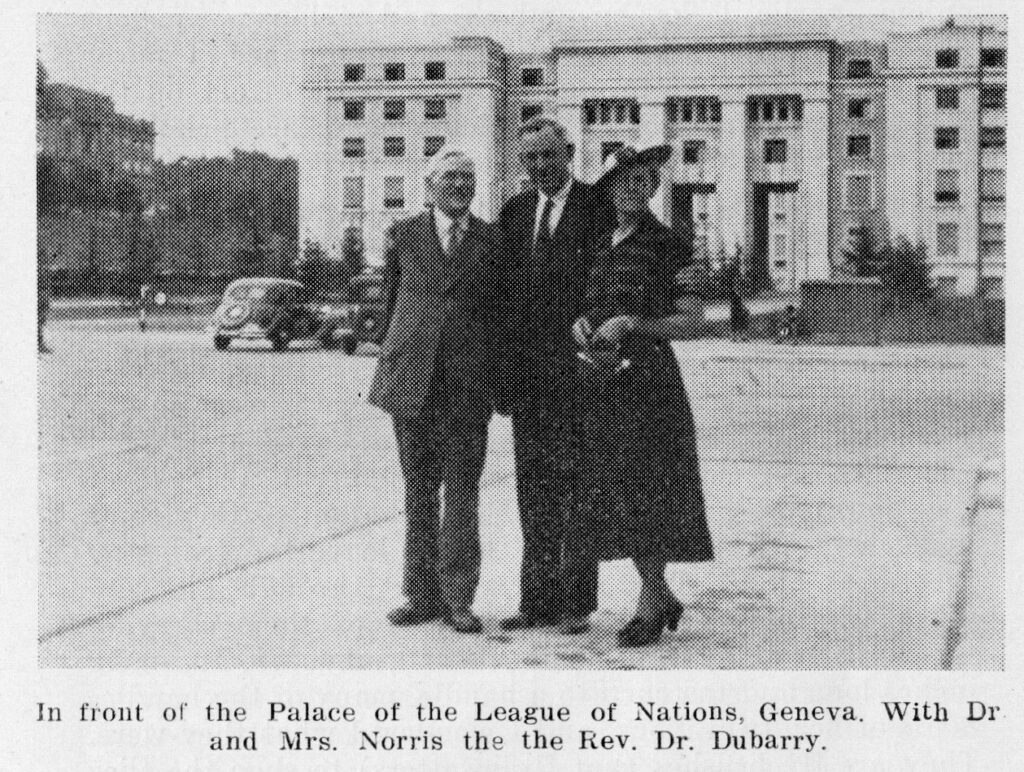
Goshen
I suppose one of the most interesting parts of all my stay in Egypt, however, was our journey throughout the Land of Goshen. Gen. 47:1-2; 5-6:
“Then Joseph came and told Pharaoh, and said, My father and my brethren, and their flocks, and their herds, and all that they have, are come out of the land of Canaan; and, behold, they are in the land of Goshen.
“And he took some of his brethren, even five men, and presented them unto Pharaoh.
“And Pharaoh spake unto Joseph, saying, Thy father and thy brethren are come unto thee:
“The land of Egypt is before thee; in the best of the land make thy father and brethren to dwell; in the land of Goshen let them dwell: and if thou knowest any men of activity among them, then make them rulers over my cattle.”
There is no doubt in my mind that it was the best of the land, for today we see signs of “flesh pots.” The onions, garlic, leeks, cucumbers, and melons – melons galore! It’s all there today and in abundance. I never saw such wealth of produce with so little effort on the labourer’s part. All tools and implements are primitive, but then you know the Nile does the work.
There in Cairo they have no mosquitoes, but on the train to Kantora, they closed the windows of the train and then sprayed the compartment and passengers with something.
We had such a lovely room in the hotel and everything was in such apple-pie order, when we were in our room we could not realize we were in Egypt at all, but when we stepped out it was very apparent. I spoke of the thousands coming in for the coronation – they came in such crowds, they did not try to leave the trains by the doors at all. They just went out through the windows. The only luggage I saw many of them carrying was a little thing like a horse’s tail, about 8, 10, or 12 inches long and fastened to a handle, many of the handles made of beautiful ivory, and I wondered what they were. They are fly brushes (not fly swatters) to shoo the flies away, and beyond all doubt, they are a necessary piece of baggage “down in Egypt.”
Crowds and Trains
The night we left, we had almost as hard a time getting out as did Moses and bis crowd. First of all, it did seem unusually hard to get information. Now, whether they didn’t want us to get away I don’t know, but we got on a through train to Jerusalem (we thought); but in a few hours we not only had to change, but had to load our selves and our baggage onto a ferry and cross the Suez Canal, then onto another train, Now if you think it’s easy to get off one train, climb up on an elevated bridge, over another train and track, find a ferry that you don’t know is in existence much less where it is, go through the customs, be sure your porter is connected with the American Express and not a thief, and all this in the dark and keep right on going and not fear, neither look back, you are pretty fair.
Finally we were on our next train. I lay in my berth, (it was too hot to go to sleep) and the preacher walked on the platform with as little clothes on as the law of Egypt would permit.
Waiting for the train to go, I had a wonderful experience. Of course it was dark in my compartment, and I could see out through a small screen, just watching the feet of people as they passed by. Did you ever think how much is told of the man by his feet? – the step, not necessarily the shoe. By far the most interesting feet that passed my window were the bare feet. They were not the bare feet of the boy “with checks of tan,” that James Whitcomb Riley describes. They were the feet of a poor people, who know not God, nor do they know anything of this world in which they live. Old men, old women – young and old alike. Their feet are so calloused they make as much or more noise than if they wore shoes. The speed of the step – the lightness of the step. the springiness of the step – all these things help to tell the mind of a man. You can almost paraphrase it, “As a man thinketh in his heart, so walketh he.”
We really did have a time getting out of Egypt and on top of all that, they got us up bright and early to “change cars” again at Lydda, and I was all awake for good by that time and my mind went to Acts 9:32:
“And it came to pass, as Peter passed throughout all quarters, he came down also to the saints which dwelt at Lydda,”
Now I’ve gotten us out of Egypt and into the “Promised Land” and in a few days I’ll begin to tell you of our stay here.
In tenderest love,
MRS. NORRIS.
P.S. – I was leaving out one of the most thrilling things I saw down in Egypt. It seemed to me to be a mob. You can’t imagine how crowded the city was – preparing for the Coronation. As we came out of our hotel, we heard thousands of people coming, yelling, singing, talking. I couldn’t tell which. I think perhaps all three, and there they stopped right in front of the hotel and began milling around. In the center of the mob two men with large sticks were doing stunts that resembled a fencing match. They evidently were trying some feats of strength; but that poor motley mob of humanity I could not under. stand, nor could they understand me – all colors, all kinds, all sizes, both men and clothes. I felt pretty small and was glad to evade them and get away.
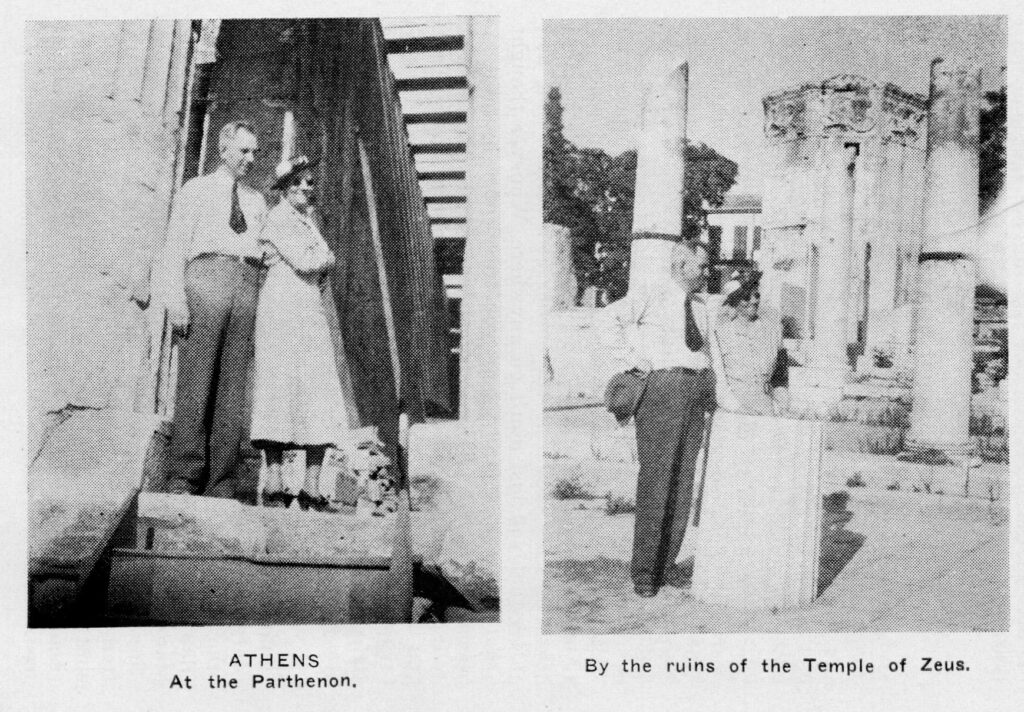
Chapter VII.
TRANSJORDANIA
Hotel Philadelphia
Amman, Transjordania
Jerusalem – Sunday
My Own Dears (Mrs. Norris’ children):
This stationery doesn’t suggest much to you, but it certainly does suggest and stand for a lot with me. I thought I had been in a few places and had some new experiences, but this is another one yet.
Last Friday afternoon, after many hindrances and delays, we left Jerusalem for the above named place Amman Transjordania – and we had to hustle because the roads are closed at the border at a certain time and after that you just don’t go anywhere. Whoever thought that I’d be in a land where you travel only by military permit? I’m sure I never once thought so. We secured our military passes at the very first, but it surely gives ne a feeling to be stopped frequently – whether in country or city – and show a military pass or permit. We have traversed and retraversed Jerusalem, however, now until they almost know us.
We reached the border in good time got past the guard and customs-and across the Jordan river. We left Jerusalem in a very moderate summer temperature, but the minute we began to to descend to Jericho – the Jordan Valley – the temperature began to rise – we had the car open, of course, but I’ll never know which would have been worse – neither could be called better. I can’t tell you how hot it felt. I may have been in hotter places, but never,one that felt so to me. I just shut my eyes and kept still. I looked at Dad and his face was actually as red as a beet. I didn’t need to look at mine. I’m glad to tell you that did not last too long – not beyond the endurance point at any rate. We began to ascend beyond Jordan.
Cold Water
The guide stopped at a village – in fact, we had to stop – military passes again – and they brought us a cup of cold water – now I mean exactly that – and it is one of those inexplicable things – how such cold water can come out in springs in that hot country. The guide told us that nearby there was a spring of water so cold you could not bear to let your finger stay in it any time at all. I do believe him, because he is truthful and because of the sample we had. A half-grown Arab boy brought us the cold water in a kind of pottery jar – familiar in South Texas and Mexico – and while he could not talk to us, yet he had me touch the water jar and was so pleased that I understood him and had found the water good and cold. They – all the Arabs around the customs – gathered around the car, and were as frankly curious as children. The prefect of police was naturally the head man – and so friendly. My! My! How nice he was! He just insisted that we get out and have tea and I was afraid we’d break some rule of etiquette not to do so – but the guide told him we were going to Amman and it was already late. I think the guide wanted to stop – and I’m sure it would have been lovely – for they are so friendly and were, of course, doing us the highest honor – inviting us to eat with them. Jallouk said they would take us in, feed us, give us a room and be happy to do it.
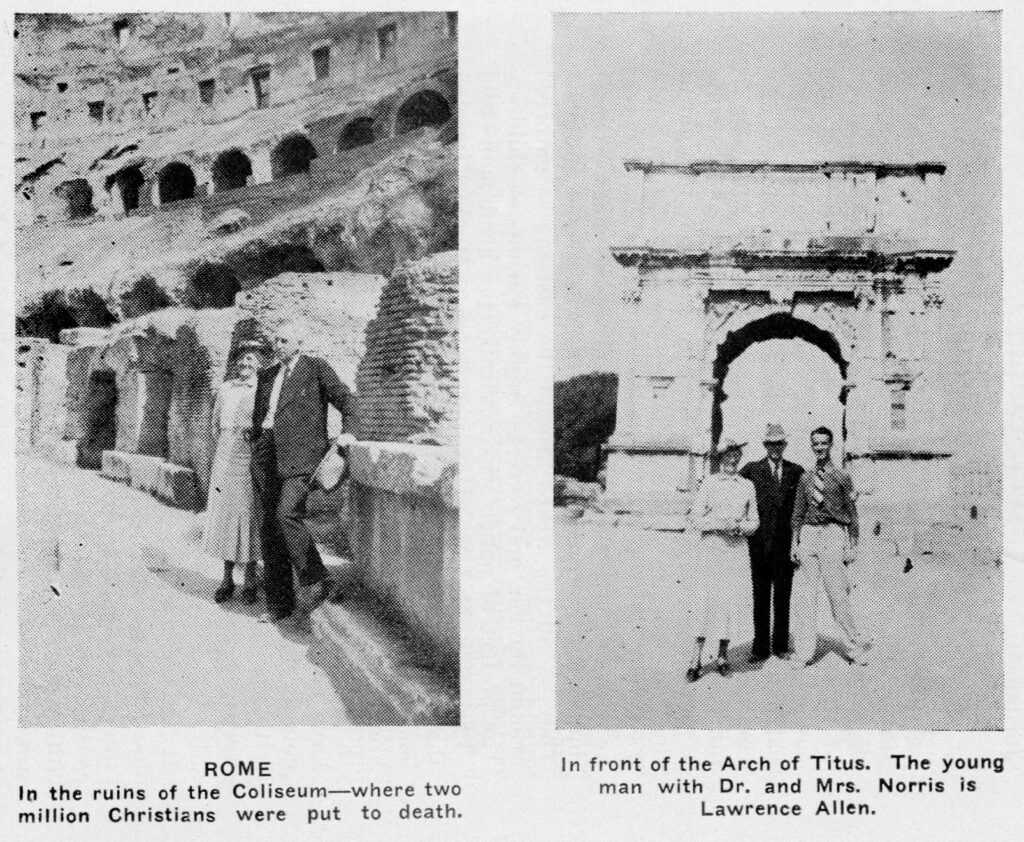
Rest
We were finally able to get away and came to the town of Amman – quite late – but I could see it was quite a little city – electric lights all over – and a high, high hill – all houses lighted up. The shops looked like prosperity and were amazed to find quite so large a town over so far in the interior – though why I don’t know. We stopped at this Hotel – Philadelphia – and you can see it’s very nice, English built and owned, I believe – though all the folks we met were Palestinian Arabs. One of then is an American citizen – has a business in the Loop in Chicago. He met a Syrian girl over there and married her. She is a good American and is crazy to get back to the good old U. S. A. I didn’t meet these people until the next morning. We arrived at the Hotel – just around dinner time, and as soon as we were in our room, Dad announced he was not hungry and was sleepy and was going to bed, and so he did. I never felt more alone in all my life. Not a human that I could say a word to except that guide – and he is, of course, an Arab too. But I stuck it out, and went down alone and had a bite – mostly a bit of tea – with lemon – though I’ve mostly quit trying to get it.
I came back soon and abbreviated all my beauty clinis, so I was asleep too. It turned out that we had mosquitoes, but they didn’t spoil that night’s rest – but
they did the next, which was last night.
To Mt. Nebo
We were up bright and early the next morning, taking pictures all over the place, for it’s quite interesting. Besides being of interest Biblically it was a strong Roman city at one time. We were delayed or rather spent quite a bit of tine in the city itself before we really got on our main objective, which was as I should have told you sooner, to go to Mt. Nebo, where Moses looked over into the promised land. As we were going along nicely – and tie morning was yet cool, Dad saw some threshing – and “oxen were treading out the grain,” and men were “winnowing the wheat,” just as in the Bible times. So Dad began, and one thing led to another. Finally we came to the threshing floor of the big Sheik. Of course Dad wanted pictures – Jallouk had already told us he was a big and important one – so things began. The boy came back saying the Sheik would receive us so we walked down to the tent and it was a typical one – oriental rugs and more rugs – and more mattresses we’d call ’em – men in all kinds of Bedouin dress – as black as coal in red dress – all of them in dresses – some of them sashes of course. There was a small bed of sprouted grain in the middle of the tent – just beyond this miniature garden was the tea set, and the fire was blazing, the water boiling and the tea made. By the way, the fuel is dried camel droppings – camels’ and cows’ – not a bit of offensive odor and it made a good fire. West Texas cowmen taught me that though – and I drank tea. Dad didn’t, and I was afraid he’d offend the whole gang. Dad tried to hurry things – but for one time things were out of his hands. They would all sit there and talk, then Jallouk would tell us what had been said – but we could only take it on faith – that they were not planning our murder.
Finally Dad began and got them moving towards the pictures and getting away. But the Sheik decided he wanted us to go up to his house. Oh, yes, he has a house, and a very fine on, too – built of stone and has tiled floors. He showed us the guest room – mostly day guests, with rugs and cushions for reclining. I saw nothing that resembled a bed, wash-basin or chair. Then he took us into what was in fact a sitting room, and I mean just that – chairs, settees, pictures on the wall – potted plants and a coffee urn – and he served us coffee – the slave did. Again Dad didn’t drink it, but I did – Dad got up again and we all got in motion. There were several men there – some visitors, I think. Some of his lieutenants too, and his poet laureate – no fooling – that’s what Jallouk said he was, and he was a good talker too.
Jallouk told us what he said about England – and I could understand the name Balfour. Now they began to talk of our eating lunch with them and insisted – we learned after we finally did get away that our host Sheik had a sheep skinned.
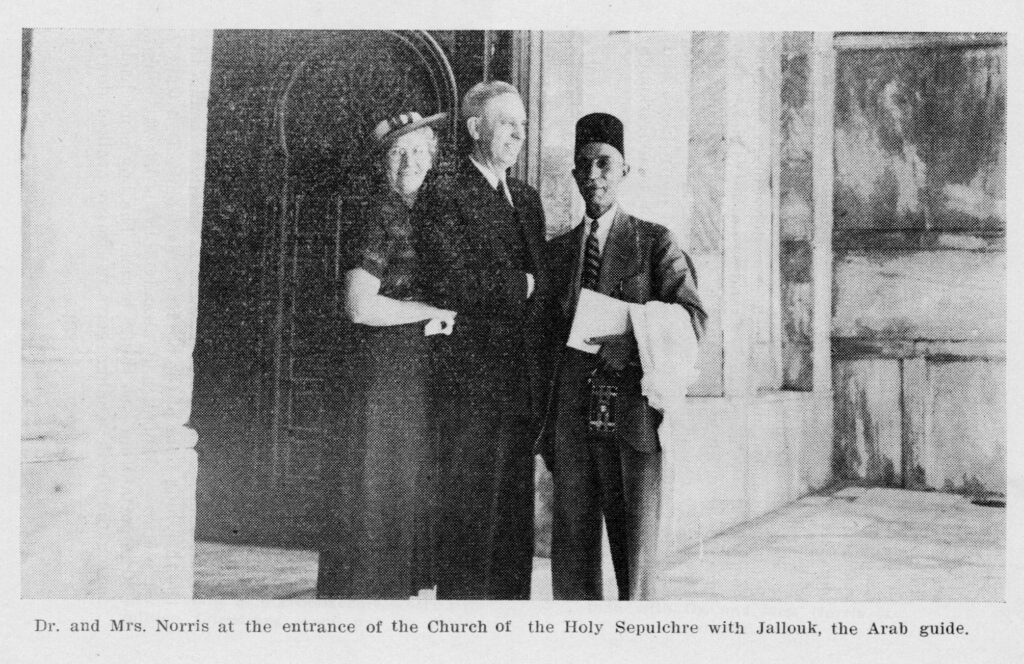
A Nice Horse
But to get back to our second start – after coffee – when we got down the stairs and out of doors, I noticed the Sheik telling Jallouk something, and when interpreted it meant that the Sheik had just given me a nice horse standing there.
His boy had been riding it along with us. I said I thanked him, accepted it and would he please keep it until I could return to fetch it. That seemed to please him so he spoke to this big black slave and he soon fetched another fine horse, much friskier and quite spirited and said that was a gift for Dad – to go with the one given me.
We should have been giving him something in the same generous spirit that he had shown – but we had nothing we could dispense with, so had to do with expressing our intentions – giving our cards with addresses, etc, etc.
It turned out later that they wanted a pair of field glasses Dad had borrowed.
It was one of the most interesting and thrilling experiences of my entire life. I really felt that I wished we had more time and something to give to please them – in other words, to play the game. Certainly in a way it was all exceedingly weird – only somehow you just knew you were safe and it was all right.
I wished I’d known more and been more like Lawrence of Arabia. I got some of my cues from that book. I was about to forget to tell you that after all this talking of giving us a fine span of horses, then he, the Sheik, insisted we must go to his tent to take the pictures. Why? I don’t know. It was a long, long way off – 400 yards or more, but fortunately he had the tent set in order with much bringing in of rugs and mats and mattresses and cushions – and started in coffee again. But at last they seemed to understand – and we got the pictures.
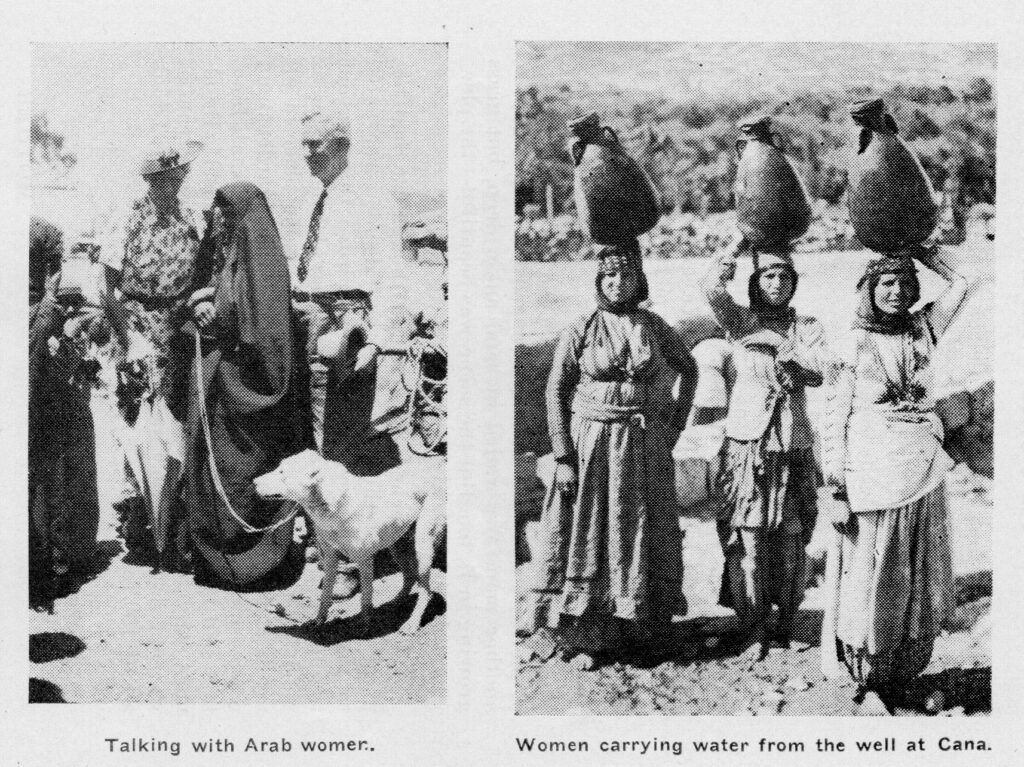
Ten O’clock and Hot!
By that time it was 10 o’clock, and oh, so hot – but when the car got in motion we were fairly comfortable. The road was good most of the way, but as we climbed higher it almost played out. But we had a good driver and soon we arrived at the top, or practically so – of Mount Nebo.
I am sure there is no doubt in the mind of any devout child of God as to why there is no certainty as to exact spots and places. But it was an exceedingly happy time to stand there on the top of the mountain and look over into the “Promised land.” We spent some time on this mountain reading and taking pictures.
We then drove back to the hotel, rested for one hour, ate lunch and left for Jerusalem.
When we came to the Jordan we took lots and lots of pictures, and Jallouk had arranged for Dad to baptize another man. We waded in sand ankle deep, but grass growing in it, too. But the scene was beautiful – the place where John baptized Jesus.
We soon reached Jericho and though we had not planned to do anything there, we both decided we wanted to visit Elisha’s pool again, so we drove there – about two miles – and what a time we did have! I never saw as much dust and as much water in the same place in all my life. If they could only be mixed! the gardens and groves and farms around Jericho show that Elisha’s fountain still has good water. Dad just tried himself. He almost stretched out in that clear, cool, rushing stream of water. I do hope every inch of the film is perfect. I took about 100 feet of it.
I love you,
MOTHER.
Part III.
Lands, Towns and Cities
Chapter IX.
UR OF THE CHALDEANS
The place from which Abraham set out on his journey to Canaan. It figures in the cuneiform inscriptions as the oldest capital of Babylonia and at the same time as an important maritime and commercial city. It is now represented by the ruins of Mughdeir on the right bank of the Euphrates.
It was the principal seat of worship of the moon-god, Sin, and is therefore sometimes qualified in the inscriptions as the “Moon city.”
EGYPT
Egypt is situated in Northeastern Africa, bounded by the Mediterranean on the north, and extends southward, including the delta and the valley of the Nile. On the east it is bounded by the Gulf of Suez and the Red Sea, and on the west of the desert.
Egypt proper consists practically of the delta and the narrow strip on each side of the Nile. The soil is celebrated for its productiveness, due to the inundations of the river, and it was the granary of Rome.
It is famous for the great antiquity and former splendor of its civilization.
Cairo is the capital and Alexandria is the seaport. The leading religion is Mohammedan, though there are many religions.
The prevailing language is Arabic.
During the early dynasties Memphis was the center. The pyramids were built during the fourth dynasty, about 4000 B.C.
The “Exodus” is believed to have been during the 19th dynasty.
The decline began with the next dynasty. with short revivals, and in the 7th and 6th centuries Greek settlements began; but in 527 B.C. Egypt was conquered by Cambyses,and this Persian dynasty began. This was overthrown in 332 by Alexander the Great. After his death Egypt was ruled by his general Ptolemy and Ptolemy’s successors down to the death of Cleopatra in 30 B.C., when Augustus annexed it to the Roman Empire.
Egypt was an important center in Christianity.
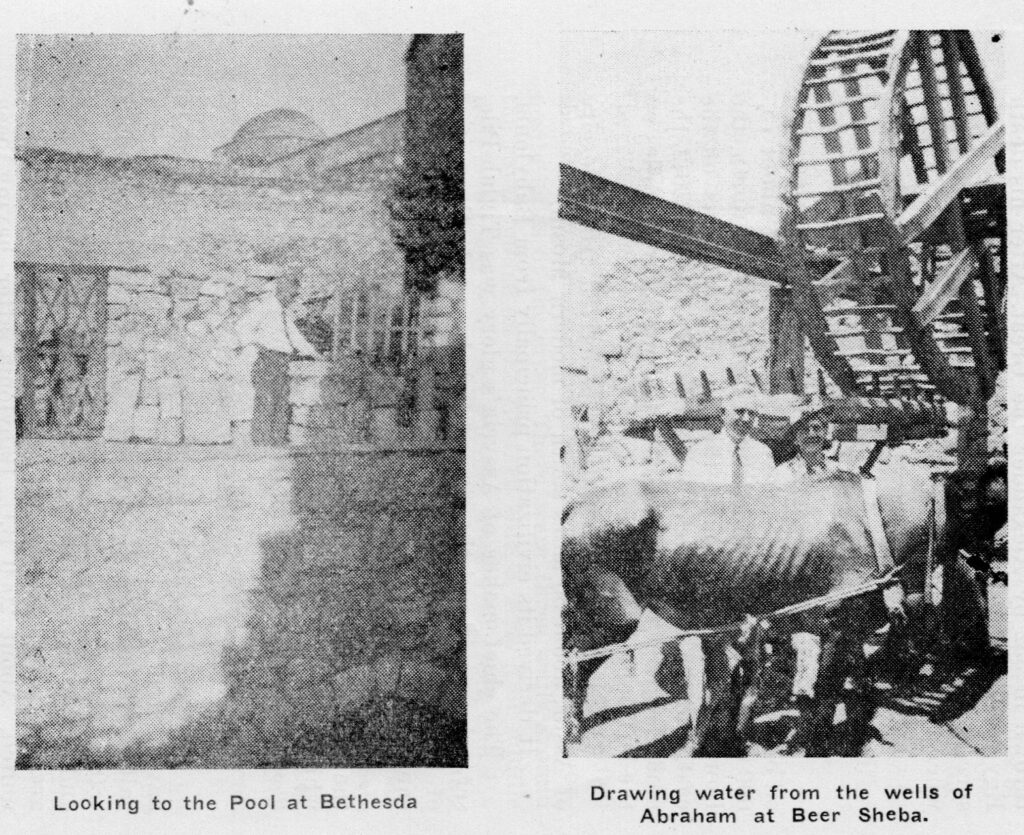
ASSYRIA
Assyria is an ancient Asiatic state, which at the period of its greatest power covered a territory of about 75,000 square miles, bounded by Armenia on the north, the Lower Zab on the south, the Sagros Mountains on the east, and the Euphrates on the west: In Genesis 10:2, the name is given to a small district about 25 by 17 miles on the left bank of the Tigris.
The name of the country was derived from the city of Assur, about 50 niles south of modern Mosul.
It derived its civilization principally from Babylonia.
The chief maker of Assyria’s glory was Tiglah-Pileser, who conquered the city of Babylon, and other cities of Babylonia, and penetrated as far as the Mediterranean.
Nineveh the ancient capital is on the right bank of the Tigris. The city was surrounded by immense walls, which had fifteen gates. Two Old Testament prophets are based on Nineveh – Jonah and Nahum.
BABYLON
The old Babylonian Empire is generally supposed to have lasted from about 4000 B.C. to 731 B.C. It is also called the Chaldean Empire. The first King Sargon about 3800 B.C. extended his sway to the Mediterranean shores, and under Hammurabi, one of the wisest and most progressive rulers of antiquity, Babylonia and Assyria were united. About 2000 B.C. Babylonia, after having been long subject to Elam, a nation of Semitic people to the cast, achieved its independence.
The city of Babylon, built 2600 B.C. on both sides of the River Euphrates, was a vast square 56 miles in circuit. The walls circling the city were three to four hundred feet high. A broad and deep moat, kept full full of water, surrounded one wall of the ancient city, outside of which was another wall 200 royal cubits high and fifty thick
There were 250 towers on the walls.
The houses were generally built of bricks and of the river mud, sun dried, or burnt in kilns, cemented with bitumen and three and four stories high.
The streets were straight, and crossed each other at right angles, the cross streets having gates of bronze at the river.
An early historian mentions a bridge of stone 3,000 feet long and 30 feet wide, connecting two palaces on opposite sides of the river. There were three walls around the royal palace on the Eastern side, a second or middle wall being 300 feet high and the towers 420 feet, and 4 1/2 miles in circuit, made of colored brick, representing hunting scenes.
A tunnel under the river also connected the two palaces. There were a hundred gates of bronze with posts and lintels of the same.
The empire lasted 1300 years. It is now a desolation. The city has become heaps. The land a wilderness for wild beasts, and even the Arabs refuse to pitch the tent, and the shepherd to fold sheep there (Isaiah 13).
The old Babylon, the capital of Hammurabi and his successors, was almost entirely destroyed by Sennacherib who leveled the city to the ground in 689 B.C. Esarhaddon built the new town on the same site by his elder son, who succeeded to Babylonia, revolted against Assyria. Babylon suffered the horrors of a siege and was eventually captured hy Assur-Bani-pal.
The fall of the Assyrian empire which followed was considered an act of divine vengeance on the king who like the predecessor Sennacherib did not offer royal homage to Marduk. In the period which followed Nabopolassar and his son Nebuchadnezzar built the city whose remains have survived until today. It was at this time that Babylon, like Bagdad under the Calliphs and Peking under Kublai Khan, attained its greatest fame.
But the end was not far off. The walls were destroyed by sieges, and Xerxes, after his capture of the city still further continued the reduction of such defensive works as remained.
In 275 B. C. the inhabitants were removed to the new city of Seleucia, and with that event the history of Babylon ends. Although the rivalry of Persian religion had done much to destroy the prestige of the old temples, and although the place was depopulated, sacrifices were still performed there in the second century B. C.
PERSIA
The Persians were centered around the southern border of the Persian Gulf. Like the Medes they were fire worshippers, believed in the age long conflict between the powers of light and darkness.
Under Cyrus the Great the Persians gained the Iranian supremacy. and founded an Empire that comprised nearly all the civilized nations of Asia. The conquest of iydia and Babylon by Cyrus, of Egypt by Cambyses, and the victories of Darius, brought the most of the known world under Persian control.
The Persian Empire stretched from east to west for 3,000 miles and was from five to 1,500 miles in width, covering nearly 2,000,000 square miles.
(Great roads and postal communications connected the cities and most distant provinces from Susa to Sardis for 1,700 miles was one road with convenient stations over which couriers of the king rode in six or seven days.
The Romans copied the Persian system of communications, which was one of the contributing causes of Roman power.
In 334 B. C. Alexander the Great crossed the Hellespont with 30,000: foott and 3,500 horse and defeated the Persians with 110,000 men. The next year he vanquished Darius at Issus, overran the whole Persian Empire, thus announcing that a new conqueror had arisen in Persia which from that time until the conqueror’s death became the eastern part of the Macedonian Empire.
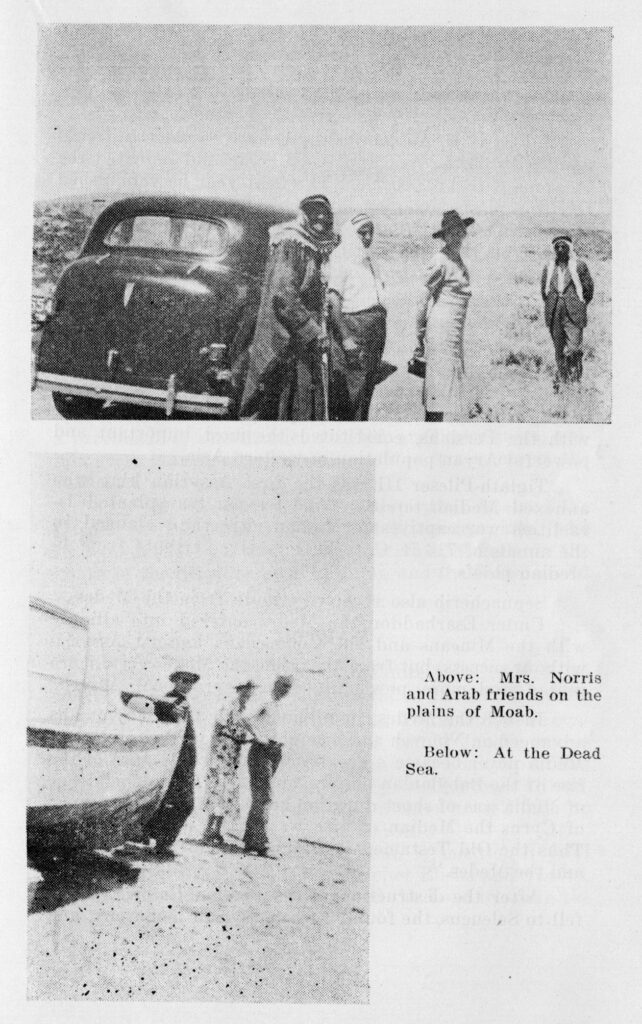
MEDIA
An ancient country comprising the northwest of the Iranian highland, extending from the Caspian Sea to Araxes. The Medes are enumerated in Genesis 10:2 as among the descendants of Japhet, and they, together with the Persians, constituted the most important and powerful Aryan population in western Asia.
Tiglath-Pileser III was the first Assyrian king who annexed Median territory, and Sargon transplanted Israelitish war captives to Median cities, and claimed, in the annals of 713 B. C. to have received tribute from 45 Median chiefs.
Sennacherib also received tribute from the Medes. Under Esarhaddon the Medes entered into alliance with the Mincans and the Cimmerians against Assyria, without success, but from that time the Medes grew more united and more powerful against tyrannical Assyria. In 608 the Medes, in alliance with the Babylonians advanced on Nineveh and brought about its downfall. But Media never became a great world empire because of the rise of the Babylonian empire, and even the independence of Media was of short duration because after the conquest of Cyrus the Median empire was bound up with Persia. Thus the Old Testament writers speak of the “Persians and the Medes.”
After the destruction of the Persian Empire, Media fell to Seleucus, the founder of the Syrian monarchy, and later to the Parthian Empire. After the Mohammedan conquest the name Media gave place to Iraq.
The old Medes were a warlike people. Isaiah XIII described them as hard and cruel.
MACEDONIA
The country north of Thessaly and the Aegean Sea, South of the Balkan mountains, extending to Thrace on the cast, and to Ellyria on the west.
There are two great plains, one watered by the Axius, which empties into the Thermaic gulf near Thessaloniea, and the other by the Strymon, which flows by Philippi and Amphipolis into the Agean Sea. Mt. Athos is a peninsular between these two plains.
Philip and Alexander ruled here, and the Romans conquered it from Perseus (B.C. 168). In the N, T. times a proconsul of one district resided at Thessalonica, ruling over Macedonia, Thessaly, and a tract along the Adriatic.
This was the first part of Europe that received the Gospel, by the labor of Paul and his companions, who first preached to a small congregation of women on the banks of the Strymon near Philippi, and the first convert was a Woman.
DOTHAN
Dothan is a very small Canaanite town, which belonged to the Tribe of Ephraim, called now El Haphire.
It is mentioned twice in the Old Testament, once connected with the History of Joseph, son of Jacob; it was there that his brethren cast him into an empty pit. But when the Ishmaelite caravan passed, coming from Gilead, Judah, his brother, advised his brethren to sell him to the men of the Caravan, and so it was.
The second time where Dothan is mentioned is II Kings 6:13. In the days of the Prophet Elisha and Thalus, son of Jehoram, where Elisha asked the Lord to smite the Syrian army with blindness. Thence he led them from Dothan to Samaria and delivered them to Jehoram the king.
CHERITH
We visited the brook Cherith. Here the prophet Elijah hid himself during the early part of the three years drouth and was fed by the ravens.
I Kings17:2-6, “And the word of the Lord came unto him, saying,
“Get thee hence, and turn thee eastward, and hide thyself by the brook Cherith, that is before Jordan.
“And it shall be, that thou shalt drink of the brook; and I have commanded the ravens to feed thee there.
“So he went and did according unto the word of the Lord: for he went and dwelt by the brook Cherith, that is before Jordan.
“And the ravens brought him bread and flesh in the morning and bread and flesh in the evening; and he drank of the brook,”
EMMAUS
Emmaus, now called el Kubeibeh, is the home of the two disciples to whom the Lord appeared on the first day of His resurrection. He accompanied them on their way home but they knew Him not until He went in with them, and at dinner time when He took the bread and blessed it their eyes were opened and they knew Him. But He at once disappeared.
It is said in Josephus that Titus built a colony there.
It is also mentioned in the Look of the Maccabees about sixty furlongs west from Jerusalem. It was called Necapolis also.
HEBRON
Hebron is one of the oldest cities – “Now Hebron Was built seven years before Zoan in Egypt” (Num. 13:22).
It is about 20 miles southwest of Jerusalem, The town, no longer wailed, with its stone houses and narrow, winding streets, stands on the eastern slope of a shallow valley. There are a great many wells there, one of which has been identified with the Pool of Hebron.
Abraham dwelt at Hebron after he requested Lot to choose and separate from him at Bethel.
Genesis 13:18, “Then Abram removed his tent, and came and dwelt in the plain of Mamre, which is in Hebron, and built there an altar unto the Lord.”
Abraham bought the Cave of Machpelah and the field from Ephron the Hittite for four hundred shekels of silver. Abraham wanted the cave especially for a burial place, and as the rest of the history of Abraham, Isaac and Jacob tells, we know that not only Sarah was buried in that cave, but Abraham, Isaac, Jacob, Sarah, Rebecca and Leah.
Visitors to Hebron must have a permit from the Mohammedan Arab Church Council to enter the present Mosque that is erected over the Cave of Machpelah.
This Mosque is so sacred to the Mohammedans that for generations past no person other than a Mohammedan by religion was permitted in the interior of the Mosque, not inside the cave – it is strictly prohibited to enter or go down to the cave. The Mosque is approached by two fights of steps, but Jews are not permitted to go beyond the seventh step.
No one knows who erected the first buildings over the Cave. It may be from the time of King David or Solomon. It was in the Byzantine era a Christian Church when the Mohammedans in A. D. 634 took the country, but it was then converted to a Mosque. In the Crusaders’ period – that is the beginning of the 12th century – it was once more a church.
In A. D. 1187 Salah Edin again returned it to a Mosque and it so continues to the present day.
To the Valley of Eschol nearby in the suburbs of Hebron the spies sent by Moses came and carried the cluster of grapes to Moses.
Hebron was chosen for a city of refuge.
At Hebron David reigned seven and a half years and was anointed the second time as king over all Israel.
It was at Hebron that Absalom rebelled against his father.
Over the Pool of Hebron David hanged the heads of Rechab and Badnah, brothers, for massacring Ishbosheth.
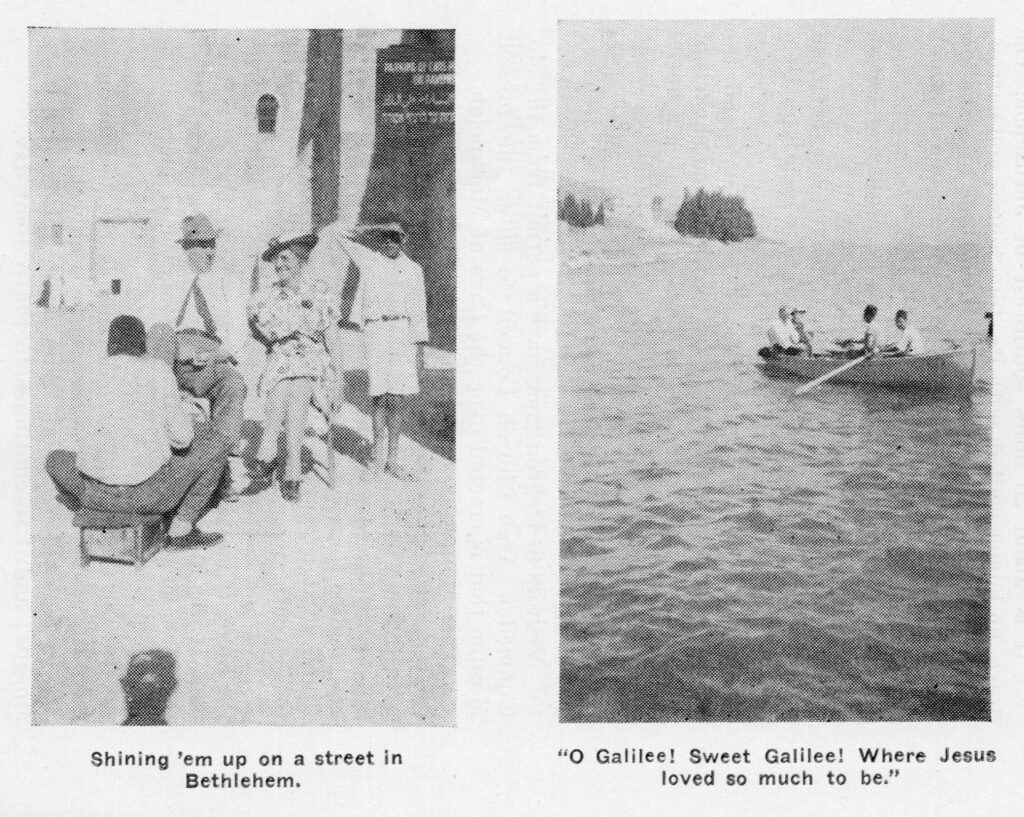
GETHSEMANE
Gethsemane, a small “farm place”, is situated across the brook Kedron at the foot of Mount Olivet to the northwest, and about one-half or three-fourths of a mile from the walls of Jerusalem.
There was a “garden”, or rather orchard, attached to it to which the olive, fig and pomegranate doubtless invited resort by their hospitable shade. And we know from the Evangelists, Luke and John, that our Lord ofttimes resorted there with His disciples.
Gethsemane’s inexhaustible associations are the off-
spring of a single event – the Agony of the Son of God
on the evening preceding His Passion.
A garden, with eight venerable olive trees, and a grotto to the north, detached from it, and in closer connection with the church of the Sepulchre of the Virgin, are pointed out at Gethsemane. When you visit the garden you ean easily believe from the appearance of the trees that. they are the same trees that were there when our Lord knelt under them in agony.
BETHSAIDA
There is no mention of this city in the old days. Its history begins after Jesus commenced His ministry. It is known as the home of three of the disciples, Peter, Andrew, and Phillip. To this place Jesus sent His disciples after feeding the five thousand.
It was one of those cities cursed by Jesus.
According to the present theory it is the present spot called Tabza. The new excavations at Tabza show a mosaic church floor which is supposed to have been erected over the spot of feeding the five thousand.
CHORAZIN
Chorazin is one of the cities cursed by Jesus. There is a place about two miles north of Capernaum called Kerazeh. The word Kerazeh means “the preaching”. Therefore there is a theory that it was here that Christ preached the Sermon on the Mount. It is about a mile north of the Sea of Tiberias.
CAPERNAUM
Capernaum is now called Tel Hum. It is not mentioned in the Old Testament. At the beginning of Jesus ministry Capernaum was mentioned often in all the Gospels and Jesus made Capernaum His headquarters while in Galilee. Therefore it is also mentioned as His home after commencing His ministry. Most of His preaching was in the famous Synagogue of Capernaum. He did many miracles there, and yet it was one of the cities of Galilee that was cursed by Jesus.
After the ministry of our Lord ended on this earth there was no mention of those cities – Capernaum, Chorazin and Bethsaida, and others on the Western side of the Sea of Galilee except Tiberias which began to flourish and is still in existence to the present day.
We visited the excavations of the Synagogue where we saw also a mosaic church floor which is dedicated to Peter according to the theory that it was built over the side of the house of Simon Peter’s mother-in-law.
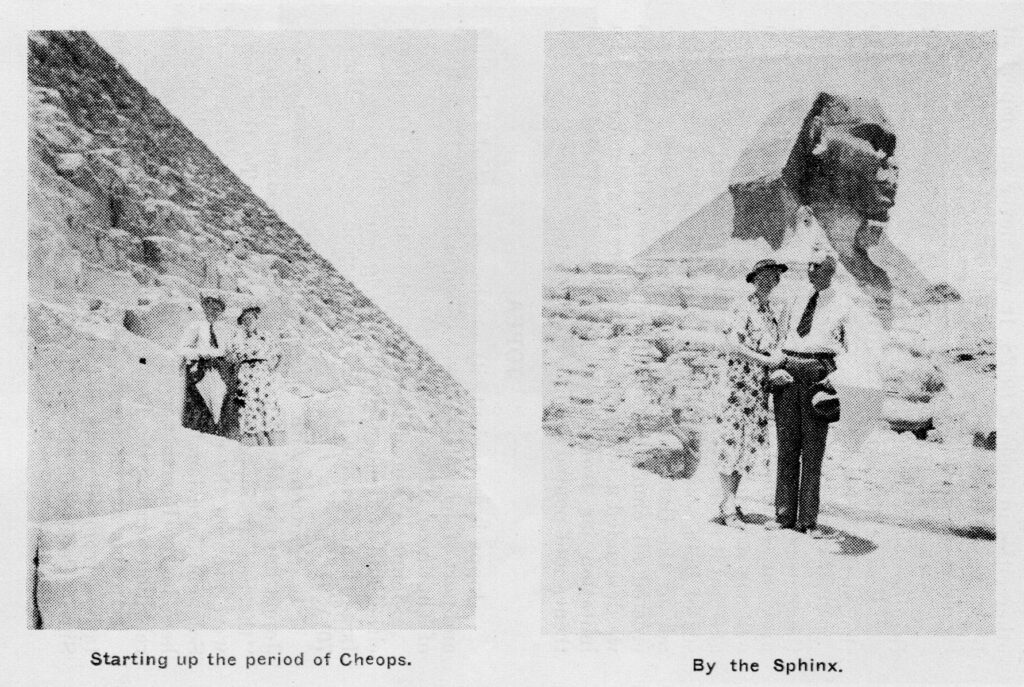
CANA OF GALILEE
Cana of Galilee, called now Kafr Kenna, was a Canaanite city given to the tribe of Zebulon. It is named with other cities in Joshua 19:28. It was never an important town to be mentioned save in the time of Jesus as mentioned in John 2:11.
In this city the Lord performed His first miracle of turning water into wine.
It is at present also a little town about six miles to the north of Nazareth.
The Catholic Church is said to have been built over the house of Nathanael. This church is built over ruins of previous churches and on entering to visit the church you will see a tablet of Mosaics written in the Greek language and it means that the first church erected by Joseph, son of Bota, son of Tanhoum. This Joseph was the governor of the Galilee District. By order of Constantine he erected all churches in Galilee. After seeing the tables we descended a few steps where there is a cistern and an imitation jar from where water is filled and carried thence and poured into the large pots.
JOPPA
Joppa is an ancient city on the sea coast of Palestine, and port of Jerusalem. It was taken in 1472 by the general of Thutmose III by a clever strategem.
Joppa is one of the most interesting Old Testament cities and is frequently referred to from the time of the Israelitish invasion to the destruction of Jerusalem in 70 A. D.
In common with other Palestinian seacoast cities, Joppa has no natural harbor. The Old Testament phrase, “the Sea at Joppa,” is literally correct. To this point were brought the cedars of Lebanon for the Temple of Solomon ; here Jonah purchased passage for Tarshish, and here in the Roman period occurred bitter reactions and rebellion against the Roman lordship in Palestine. In this old metropolis of Palestine, where representatives from all parts met on quaint and narrow streets, Simon Peter had the vision of the world-wide scope of the new faith which he was soon to announce to Cornelius at Caesarea. And it was here that Peter restored Tabitha to life.
Joppa was the home of Dorcas and of Simon the tanner whose house stood by the sea. Modern tanneries still line the beach where hundreds of skins are cleansed by the pounding waves.
The town itself is very picturesque, occupying a commanding position on a headland 125 feet above the Mediterranean. It is of course on the great highway which cuts through the plains of Sharon and Philistia north to Syria and south to Egypt. It was accordingly as prime importance in all matters involving military interests between east and vest. It is now at the junction point of the Palestine Railway from Kantara to Jerusalem.
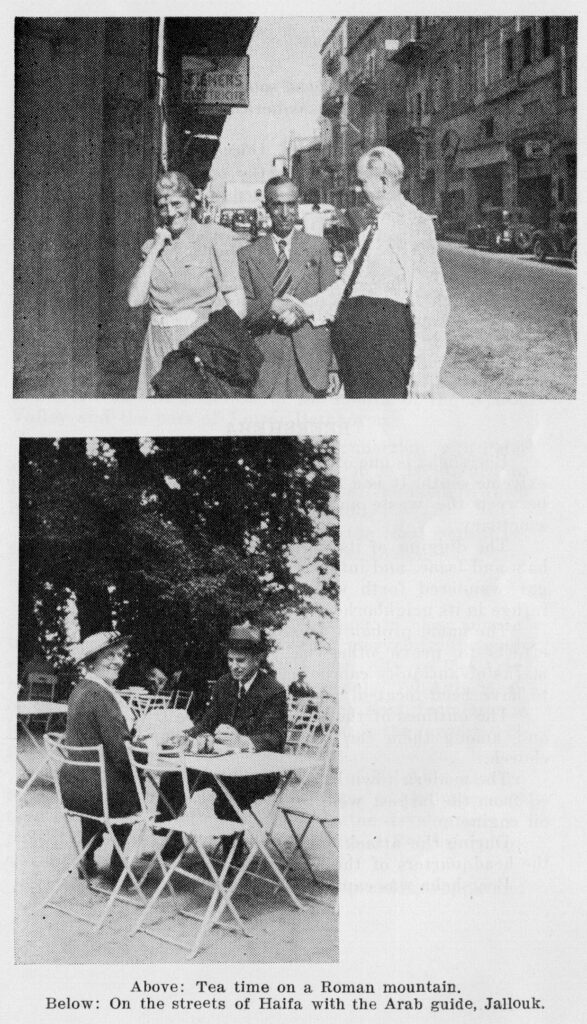
BEERSHEBA
Beersheba is one of the oldest places in Canaan in the extreme south. It is a Simeonite town on the border line between the waste and the cultivated land – a famous sanctuary.
The digging of its wells is attributed to both Abraham and Isaac, and into the wilderness of Beersheba Hagar wandered forth with Ishmael. Here Elijah sought refuge in its neighborhood from the vengeance of Jezebel.
The name probably means “seven wells” in spite of efforts to prove otherwise. Three wells with evident marks of antiquity can be seen and four others are said to have been located.
The outlines of the ancient town are still discernible and among them can be traced the foundations of a church.
The modern town has an installation of water pumped from the largest well, the “well of Abraham,” by an oil engine.
During the attack on Egypt in World War I it was the headquarters of the Turkish army.
Beersheba was captured by British troops on Oct. 31, 1917, a brilliant charge into the town by the Australian mounted division saving the wells from destruction by the Turks.
LYDDA
A city of Dan, ten miles east from Joppa; once called Lodd.
Standing on the southern border of the Plain of Sharon, Lydda is mentioned only in Acts. The town was situated at the northwestern end of the territory occupied by the restored Jewish community. Lydda was in close proximity to Joppa on the international highway between Egypt and Mesopotamia. At its door was Modin, home of the Maccabees, while to the southeast lay Emmaus of the Plain. All of this area was at the mouth of the Ajalon Valley and the pass of Lower Bethhoron.
Lydda appears in Acts only in connection with Peter and Aeneas; in the Old Testament it is mentioned as Lod in the lists of returning captives, The modern town bears practically the same name, Ludd.
The Arabs have a tradition that the final contest between Christ and Antichrist will be at Lydda.
TEL-AVIV
Immediately to the north of Joppa, in close connection with the older city, is one of the marvels of the modern Zionist movement, the all-Jewish city of Tel-Aviv, boasting a population of 150,000 people. Tel-Aviv is an occidental town at the gateway to the East, forming the largest urban section of Palestine and is the largest self-governing Jewish city in the world.
Meit Dizengoff, the first Mayor of Tel-Aviv, startedto collect paintings and left his house to the town and they converted it into a museum, In the development of painting and graphic arts the museum in Tel-Aviv plays an important part.
Within the vicinity of these twin cities, Joppa and Tel-Aviv, are some of the finest colonies created by Zionism in its supreme effort to reclaim for the Jews the land of their fathers.
Most visitors do not see these little settlements which are the real evidence of Zionism ‘s vitality and the ultimate test of its success. Most travelers visit Tel-Aviv; however, it is rather an excresence on Zionism than its normal fruit. It looks like a boom town in the Middle West with its raw newness, its paved streets, modern buildings, electric light plant, Western stores. Like the Zionism which it represents, it stands for the aggressive invasion oỉ a new civilization. The contrast is vivid as one turns to Jaffa’s neighboring bazaars and streets so Orientally picturesque. Not here in Tel-Aviv, but out in the colonies where pioneers invest life itself in the reclamation of the Holy Land, are alike the lure and hardship, the test and the possible tragedy of Zionism.
HAIFA
It has lately grown into the most important port of Palestine, with a thriving industrial and trading population. The city of Haifa is at the foot of Mount Carmel at the southern end of the Bay of Acre. It is a port with a depth for the greater vessels. It is a terminal point of three railroads. It is also the terminal for pipe lines bringing oil from Iraq to the Mediterranean. The population of Haifa grew from 35,000, mainly Arabic, in 1928 to 105,000 in 1939. The new immigrants have been mostly Jewish who have built and settled modern suburbs on the slopes and on the top of Mount Carmel and in the plain northeast of the town, where they founded large textile, cement and soap factories and flour mills.
JERICHO
Twenty-five miles northeast from Jerusalem is Jericho, in the Jordan valley.
When the children of Israel crossed the Jordan River Jericho was a large and strong city. It was the first city attacked by Joshua after crossing the Jordan, and by the miraculous aid of the “Captain of the Hosts of the Lord” the walls “fell down flat” and the city and its inhabitants except Rahab and her family were destroyed.
The Jewish pilgrims going up to Jerusalem used to assemble at Jericho, and Christ passed through it several times.
It was in Jericho that Jesus met Zacehaeus.
On the Road to Jericho many wonderful events took place.
It was the scene of the parable of the Good Samaritan.
One day when Jesus passed over this road He found Blind Bartimaeus waiting expectantly and rewarded his faith by giving to him his sight.
JORDAN
Jordan is the great river of Palestine, rising from two springs in the valley between Lebanon and Hermon. The whole length of the Jordan is only 120 miles in a direct line, but in its windings it is above 240 miles.
Throughout history the Jordan has roughly divided the settled from the nomadic populations, The crossing of Jordan one way or another was always an event in the history of Israel.
It is first mentioned in Genesis 13:10:
“And Lot lifted up his eyes, and beheld all the plain of Jordan, that it was well watered every where, before the Lord destroyed Sodom and Gomorrah, even as the garden of the Lord, like the land of Egypt, as thou comest unto Zoar.”
It was crossed by Jacob – Genesis 31:9-10:
“And Jacob said, O God of my father Abraham, And God of my father Isaac, the Lord which saidst unto me, Return unto thy country, and to thy kindred, and I will deal well with thee:
“I am not worthy of the least of all the mercies, and of all the truth, which thou hast shewed unto thy servant: for with my staff I passed over this Jordan; and now I am become two bands.”
It was passed over by the Israelites when entering the Promised Land. Other wonderful miracles are associated wit!h it, as the curing of Naaman.
As we look upon its rolling waters we recall the account of the baptism of the multitudes and Jesus’ own baptism by John.
“And, lo, the heavens were opened unto him, and he saw the Spirit of God descending like a dove, and lighting upon him:
“And, lo, a voice from heaven, saying, This is my beloved Son, in whom I am well pleased.”
MEGIDDO, OR “ARMAGEDDON”
Megiddo is an ancient city at the foot of Mount Carmel in the plain of Jezreel. It was one of the capitals of the Canaanites and became one of the strongholds of the tribe of Manasseh. The valley or plains surrounding this city is a celebrated battlefield in the history of Israel. It has become a symbol for terrible conflict and grief.
Zechariah 12:11, “In that day shall there be a great mourning in Jerusalem, as the mourning of Hadadrimmon in the valley of Megiddon.”
There were many bitter and decisive battles fought here.
Near here Deborah and Barak defeated Sisera and the Canaanites.
It was here that Gideon’s 300 defeated the Midianites.
Saul took his own life during the invasion of the Philistines.
Ahaziah fled here from Jehu, and the good king Josiah was mortally wounded by Pharoah Nechoh.
During World War I General Allenby won a great victory over the Turks on this historic plain.
And finally it will be the scene of the last great battle when all the enemies of God will be destroyed.
Rev. 16:16, “And he gathered them together into a place called in the Hebrew tongue Armageddon.”
BETHANY
On the road to Jericho from Jerusalem, just around from Gethsemane, on the eastern side of Olivet are the ruins of Bethany, the home of Mary, Martha and Lazarus where Jesus often after a hard day’s work, healing and preaching in the crowded city, would slip away and spend the night in the humble home of these intimate friends.
It was from Bethany that He made His triumphant entry into Jerusalem, riding on a colt, while the disciples followed crying, “Hosanna; Blessed is he that cometh in the name of the Lord.”
MOUNT CARMEL
Mount Carmel is part of a mountain range that projects into the Mediterranean Sea and stands as a wall between the plain of Sharon and Esdraelon.
It is whale-back in appearance and stretches in a southeasterly direetion into the heart of the plains of Megiddo. It is in full view of Nazareth.
The mountain is formed of hard gray limestone with veins of flint. It abounds in caves and is covered with rich vegetation. The highest part is 1742 feet above the sea. Its grottoes were the abodes of Christian hermits from the early times of Christianity. It is kept sacred not only by the Jews and Christians, but also by the Mohammedans.
It is easy to understand why Elijah would use this mountain for a pulpit. Indeed it would be easy to speak to “All Israel” and they could all see the offering of the sacrifice consumed by fire from heaven.
I Kings 18:20, “So Ahab sent unto all the children of Israel. and gathered the prophets together unto Mount Carmel.”
They could all see old Elijah walking about ridiculing the priests of Baal. He wanted them to know his contempt for them, in their vain attempt to bring down the fire from heaven.
“All Israel” could see Elijah dig the trench around the altar and put the wood in order.
“All Israel” saw the water ran round about the altar.”
Then “all Israel” saw and heard that marvelous prayer of only 63 words:
“Lord God of Abraham, Isaac, and of Israel, let it be known this day that thou art God is Israel, and that I am thy servant, and that I have done all these things at thy word.”
Then “All Israel” saw the fire coming out of the clear skies – God answering the prayer of his true prophet. What emotions stir my soul as I stand on this mountain and look over the blue water of the Mediterranean!
GALILEE
The Sea of Galilee is the most historic body of water in all the world. It is 13 miles long and an average of seven miles wide. Its waters are cool, clear and beautiful, abounding in excellent fish. Galilee gets its name from the fertile distrait which forms its west shores. Its greatest depth is 160 feet, and its surface varies from 600 to 700 feet below the level of the Mediterranean Sea.
It is somewhat in the shape of an harp. The Jordan river flows through it, entering at the northeast and flows out at the southwest part.
The hills which close in upon the sea on the southwest side recede from the shore towards the north to form a great natural amphitheatre with the Plain of Gennesareth as arena. Unlike the Dead Sea, there is between the water’s edge and the foot of the hills a clear passage all around the lake.
In the neighborhood of this beautiful body of water Christ spent much of His childhood and ministry.
At this beautiful spot I always recall the song,
“O Galilee! Sweet Galilee!
Where Jesus loved so much to be;
O Galilee! blue Galilee!
Come, sing thy song again to me!”
SAMARIA
The district of Samaria embraces the ancient land of Ephraim and Manasseh, west of the Jordan, having Galilee on the north of Jordan on the east. Judea on the south and the Mediterranean on the west.
The ancient city of Samaria was located on a high hill in Ephraim. The name means “watch mountain.” It is surrounded by a broad basin-shaped valley. Here Omri the sixth king of Israel built the capital of the kingdom of Israel on the hill in B.C. 925.
When Shalmanezzar, king of Assyria, took the city of Samaria in B. C. 720 and carried the ten tribes of Israel away as prisoners, Esarhaddon re-peopled the country from Assyria who brought their gods with them, and from them descended the Samaritans of the New Testament. Although priests were sent to instruct these foreigners in the “worship of Jehovah” the population had a mixed belief and practice.
But when the Jews returned from captivity, they would have nothing to do with the Samaritans and the breach between the two peoples was widened and the Samaritans set up a rival temple on Mount Gerizim. In the time of Christ the hatred between the Jews and the Samaritans led by Sanballet was still so bitter that the Galileans avoided passing through Samaria. The Samaritans were of heathen origin and tendencies and yet many of them gladly embraced the gospel, as in the ease of the woman at the well.
Philip preached the gospel to them in Acts 8:18:
“Then Philip went down to the city of Samaria, and preached Christ unto them.
“And the people with one accord gave heed unto those things which Philip spake, hearing and seeing the miracles which he did.
For unclean spirits, crying with loud voice, came out of many that were possessed with them: and many that were lame, were healed.
“And there was great joy in the city.”
Herod the Great rebuilt the city with some splendor and called it Sebaste, after the Emperor Augustus. The whole hill is covered with rubbish. The ruined church of John the Baptist bears traces of its former magnificence.
The prophecy of Micah is descriptive of its present condition:
Micah 1:6: “Therefore I will make Samaria as an heap of the field, and as plantings of a vineyard: and I will discover the foundations thereof.”
Hosea 13:16, “Samaria shall become desolate, for she hath rebelled against her God: they shall fall by the sword: their infants shall be dashed in pieces.”
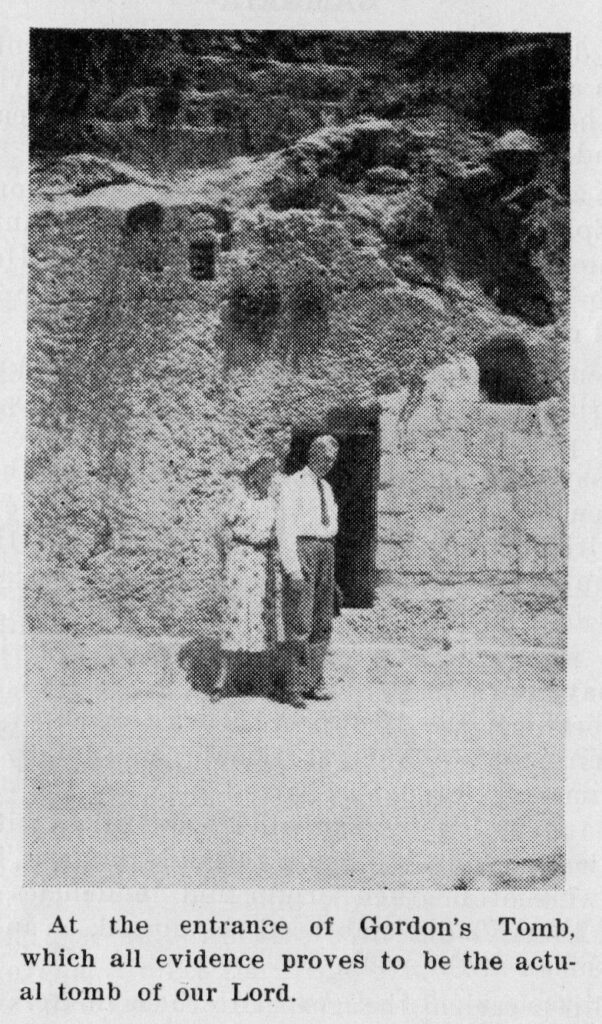
CANA
Cana, of Galilee, the scene of Christ’s first miracle when he turned the water into wine at the marriage feast – “This beginning of miracles did Jesus in Cana of Galilee, and manifested forth his glory; and his disciples believed on him” (John 2:11). It was also the home of Nathanael.
There are Latin and Greek churches, the former occupying the site of an ancient basilica claimed to be of the age of Constantine. Mosaic paving with an early Hebrew inscription has been discovered below its floor.
NAZARETH
Nazareth, a town of Lower Galilee, is on the northern border of the plain of Esdraelon, 1,600 feet above sea level. There are numerous places of worship and charitable institutions in the town. The industries are lace-knitting, and the manufacture of mementoes for sale to tourists.
Nazareth is not mentioned in the Old Testament. It first became known as the place where Jesus spent His youth. The village was the home of Joseph and Mary, and to it they returned after the flight to Egypt. In its synagogues Jesus preached the sermon that led to His rejection by His fellow-townsmen.
Today visitors are shown the church of the Annunciation, the workshop of Joseph, St. Mary’s well, Christ’s table, the place of precipitation, etc. Only for the well can authenticity be assured.
Of the identification of the ancient site there can be no doubt. The name of the present village is “en-Nazirah,” the same, therefore, as of old. It is a better class of eastern villages – a few are Mohammedans, the rest Latin and Greek Christians.
The origin of the disrepute in which Nazareth stood (John 1 :47) is not certainly known, All the inhabitants of Galilee were looked upon with contempt by the people of Judea because they spoke a ruder dialect, were less cultivated, and were more exposed by their position to contact with the heathen.
But Nazareth labored under a special opprobrium, for it was a Galilean and not a southern Jew who asked the reproachful question, whether “any good thing’ could come from that source.
Among the “holy places'” which the legends have sought to connect with events in the life of Christ, two localities are of special interest. One of these is the “Fountain of the Virgin,” situated at the northeastern extremity of the town, where, according to one tradition, the mother of Jesus received the angel’s salutation (Lk. 1:28).
The other place is that of the attempted Precipitation. Above the town are several rocky ledges, over which a person could not be thrown without almost certain destruction. But there is one very remarkable precipice, almost perpendicular, and 40 or 50 feet high, near the Maronite church, which may well be supposed to be the identical one over which His infuriated townsmen attempted to hurl Jesus,
GORDON’S CALVARY
Various sites have been suggested for “the place of the skull,” termed Calvary in Luke, and Golgotha in Matthew, Mark and John.
It was outside the walls of Jerusalem but “nigh to the city.”
John 19:20: “This title then read many of the Jews: for the place where Jesus was crucified was nigh to the city.”
Two of these sites are only now considered seriously, namely,
(1) The one accepted since the time of Constantine and it is within the Church of the Holy Sepulchre.
(2) The other one is known as Gordon’s Calvary, a knoll partly covered by Moslem graves outside the Damaseus Gate.
General Gordon, while in Jerusalem three years before his death at Khartum, was struck by the resemblance of this knoll to a skull.
On the knoll is the quiet garden containing a rock-hewn tomb which is thought by many to be the sepulchre in which the body of Jesus was buried. It was discovered in 1867.
“And in the garden a new sepulehre.”
There are tremendous difficulties in the way of deciding whether or not the Church of the Holy Sepulchre – built on the site of Constantine’s House of Prayer and other early edifices commemorating the Tomb of Jesus and the place of Calvary – was inside the walls of Herod’s city as it is within those of present day Jerusalem.
These difficulties have led many to think that the eminence outside the Damascus Gate known as “Gordon’s Calvary” is the genuine site of Golgotha and to identify the Garden Tomb, near the summit as the sepulchre.
MOUNT OLIVET
It is a well-known eminence on the east of Jerusalem, intimately connected with some of the gravest events of the history of the Old Testament and the New Testament, the scene of the flight of David and the triumphal progress of the Son of David, of the idolatry of Solomon, and the agony and betrayal of Christ.
It is not so much a “mount” as a ridge, of rather more than a mile in length, running in general direction north and south, covering the whole eastern side of the city. At its northern end the ridge bends round to the west, so as to form an enclosure to the city on that side also. Put there is this difference, that whereas on the north a space of nearly a mile of tolerably level surface intervenes between the walls of the city and the rising ground, on the east the mount is close to the walls, parted only by that which from the city itself seems no parting at all – the narrow ravine of the Kidron.
It is this portion which is the real Mount of Olives of the history.
